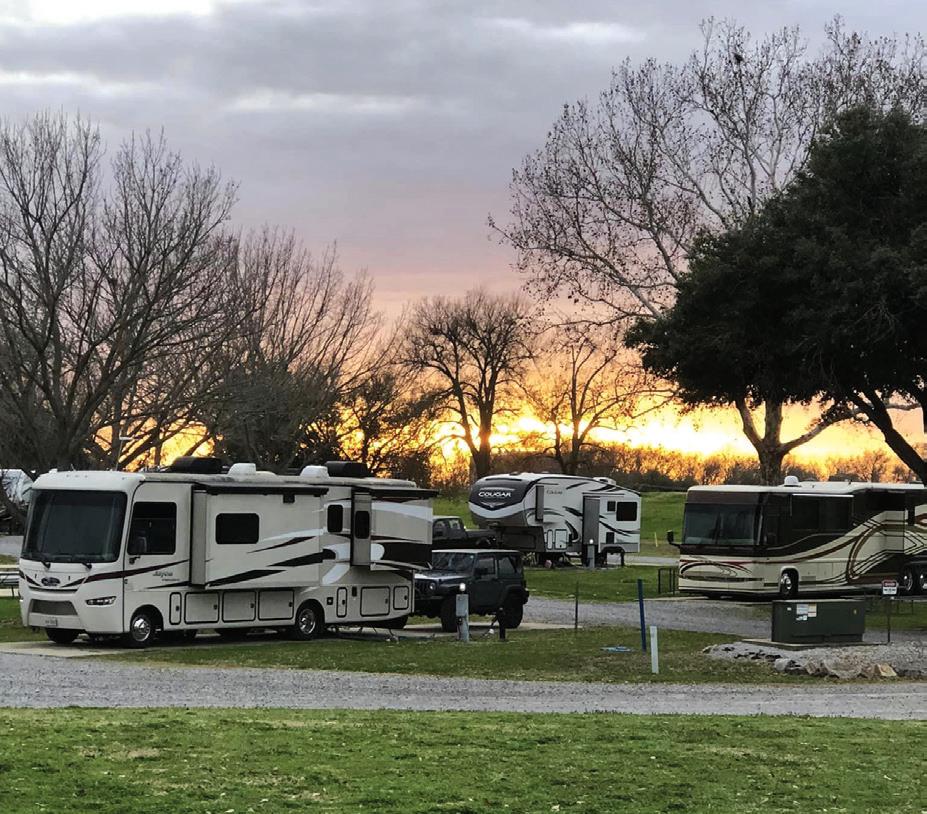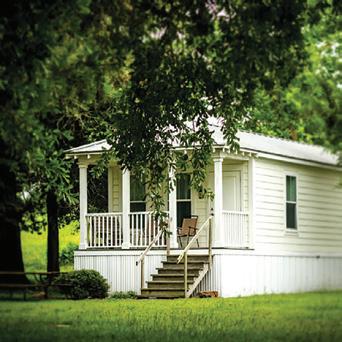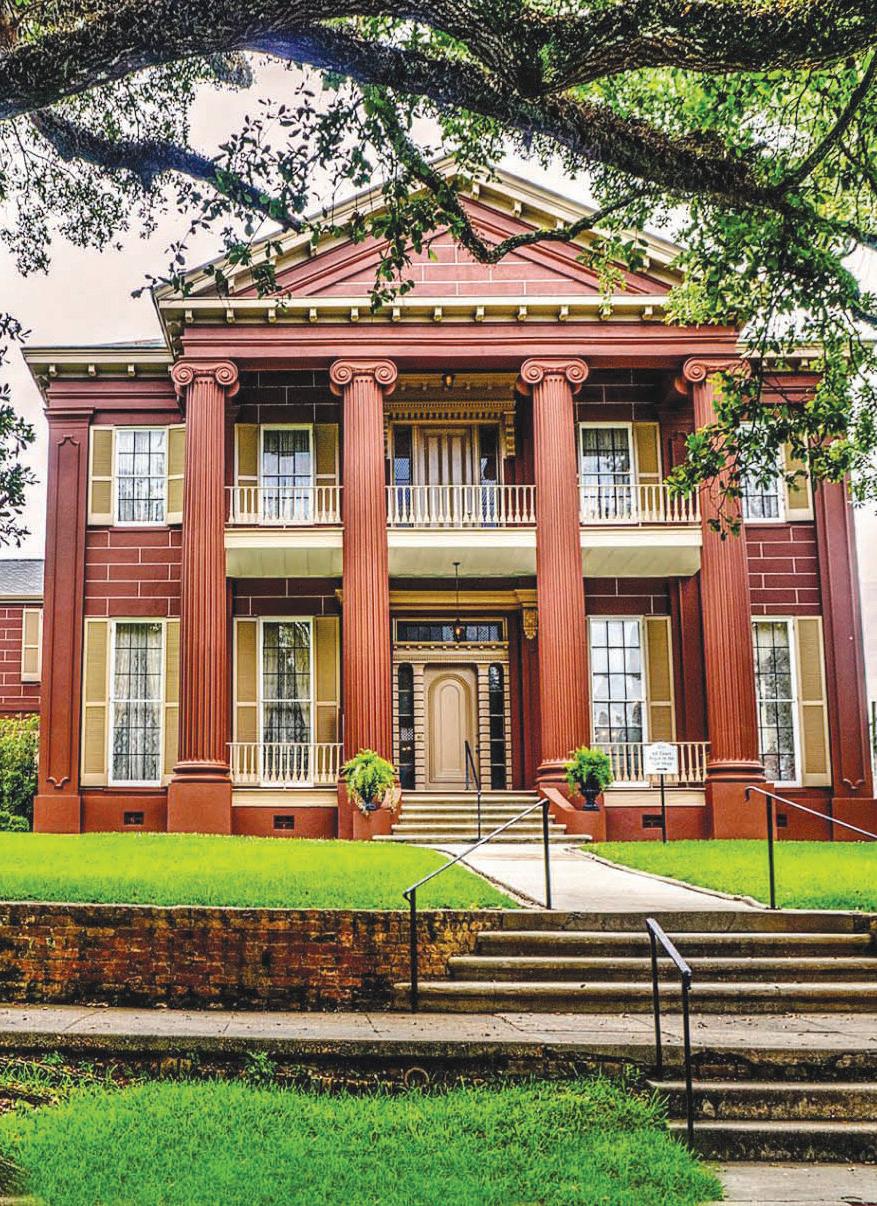
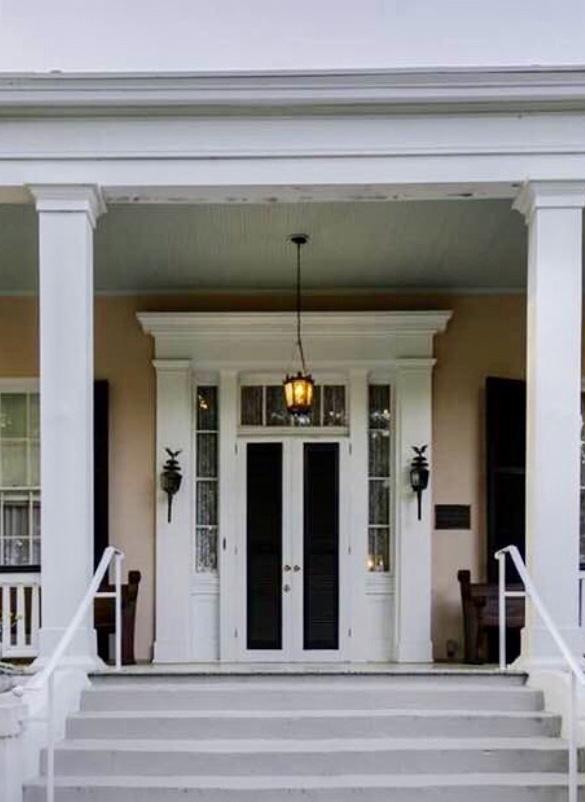
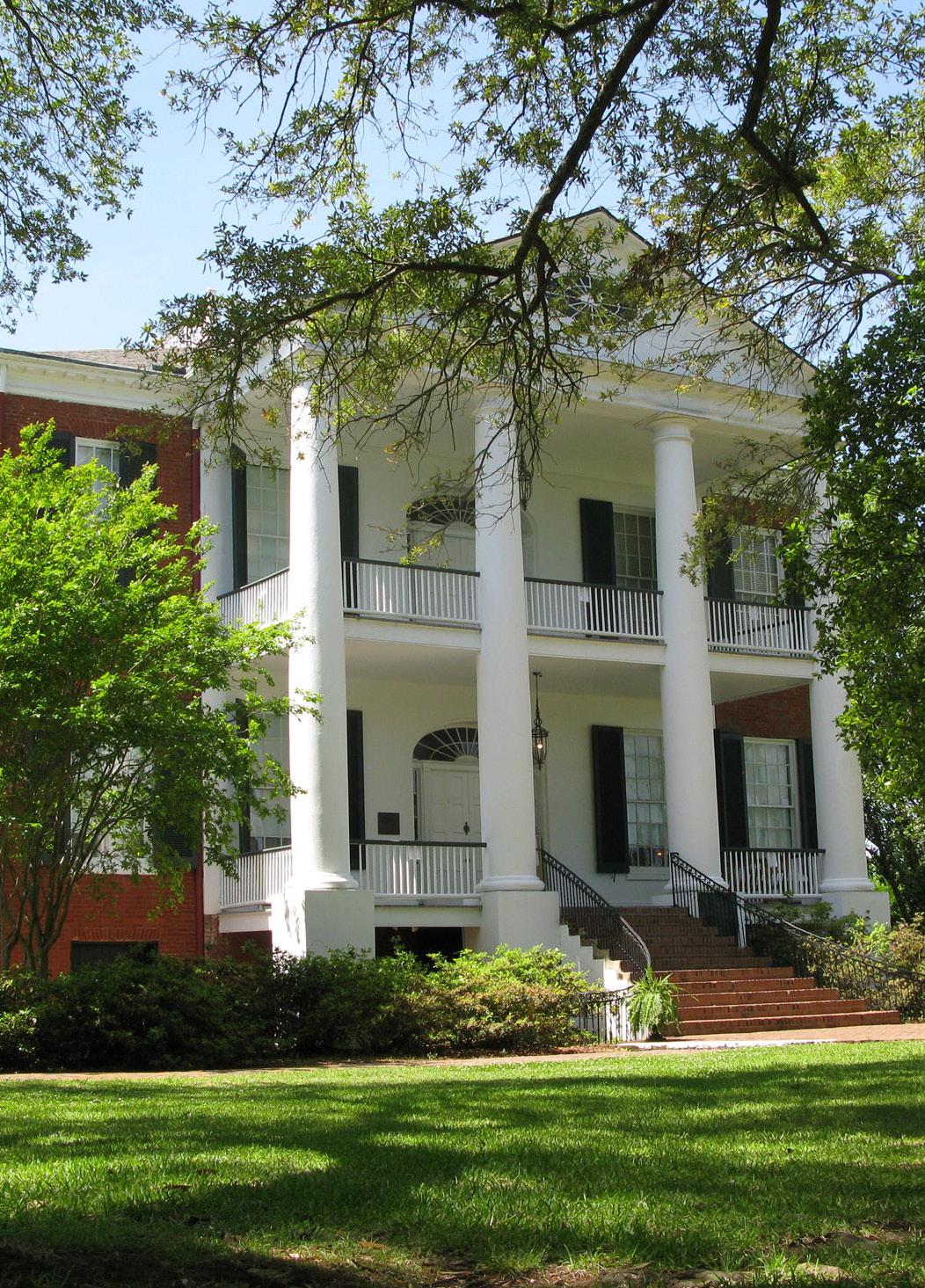




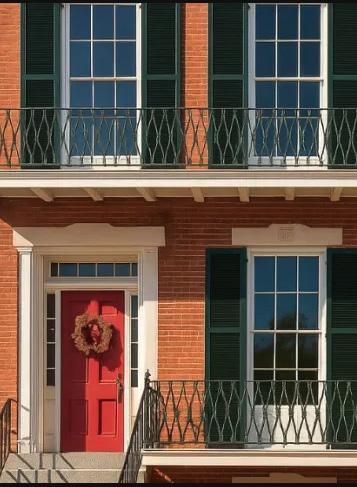


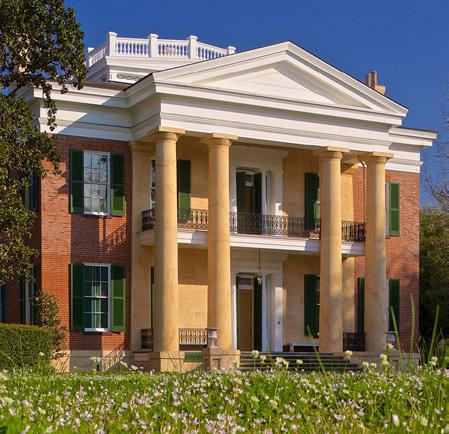


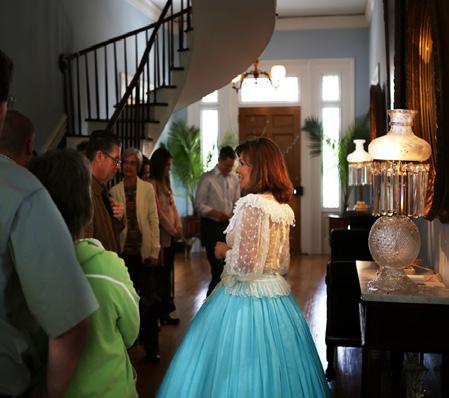

Spring blooms. Summer activities sizzle. Fall festivals bring fun. Holidays sparkle. No matter the time of year, “The Little Easy” captures hearts.
Today, we are witnessing a Natchez Renewal. New Businesses and Jobs. Hot Real Estate. Investment in Infrastructure, Parks, and Workforce Training. More Cruise Line dockings. A blooming Movie industry. And a Social Calendar that never stops. Whether it’s a short visit or your new home, we’re ready to welcome you to Natchez all year round!
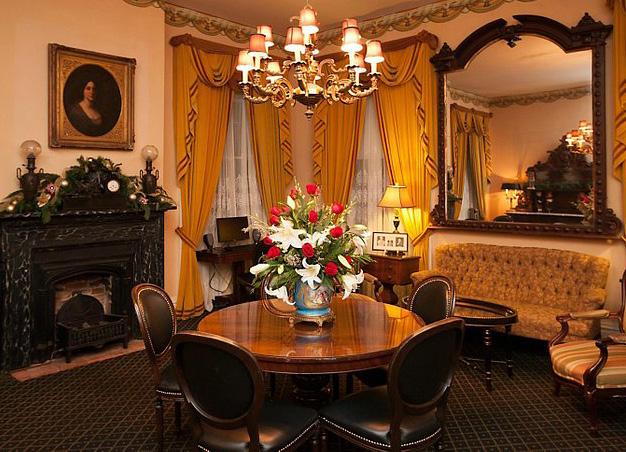
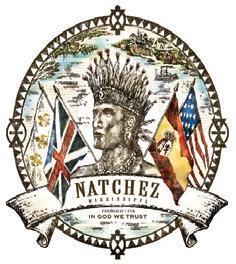
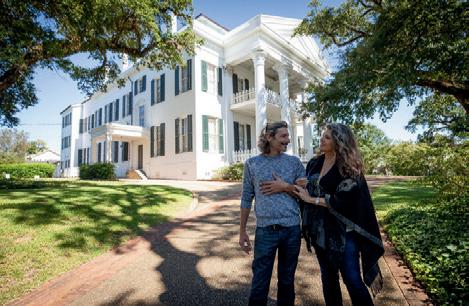




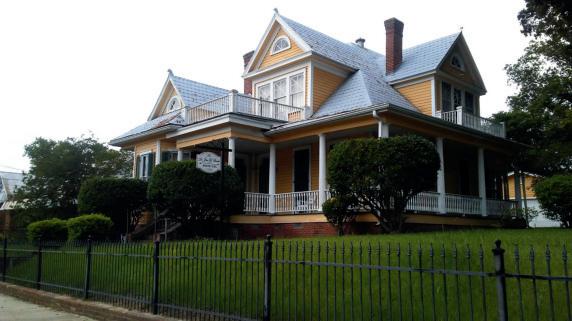
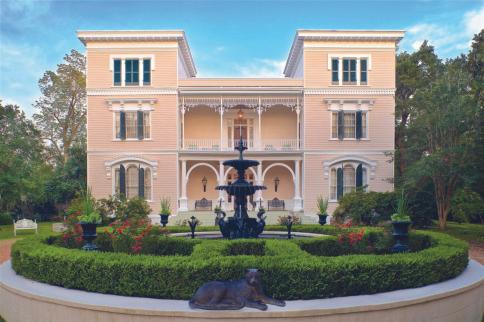



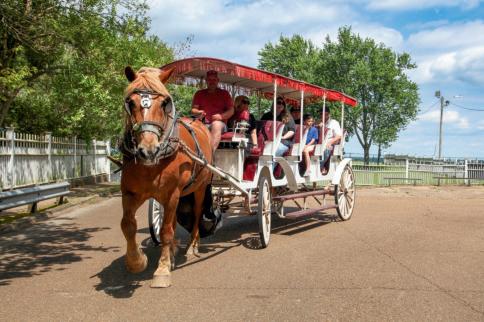
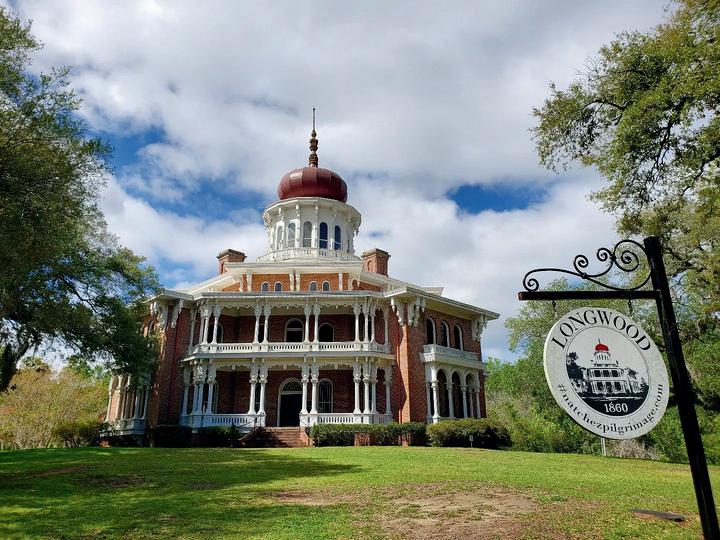




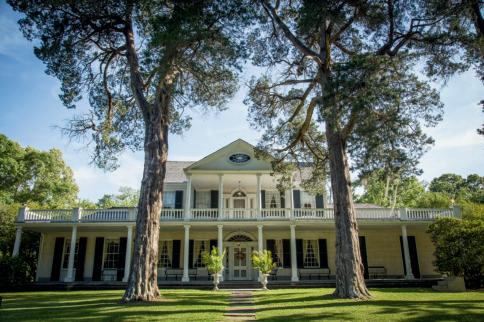
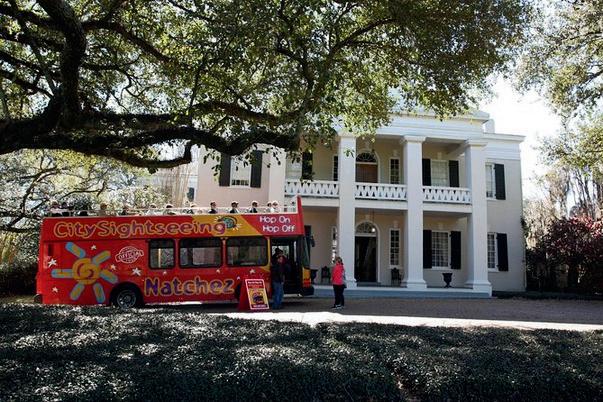
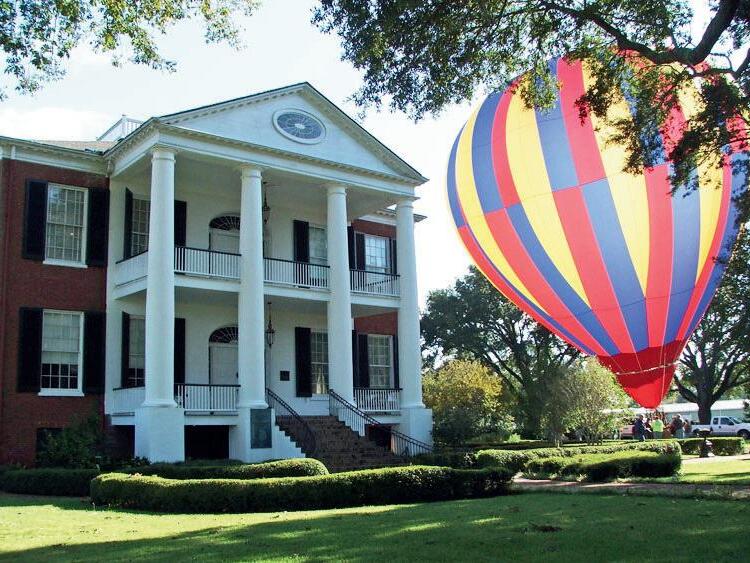


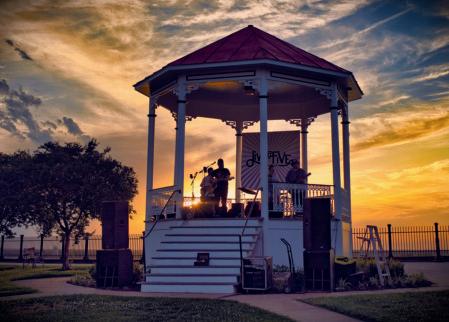
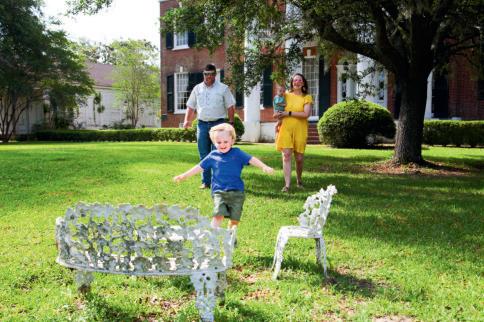


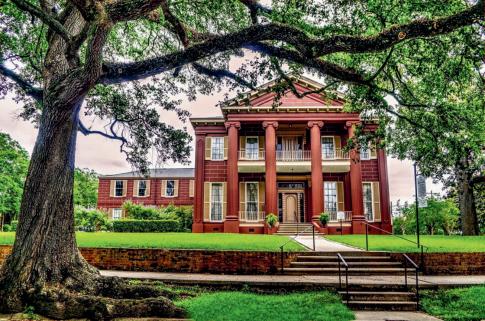

Welcome to Fall in Natchez! It’s a time our community shines, with more than two dozen historic properties on tour through Natchez Garden Club and Pilgrimage Garden Club pilgrimages. In addition, visitors can participate in a wide variety of events to enjoy in-depth history, fine dining and drinks and musical entertainment.
For Natchez Garden Club, Fall Pilgrimage begins on Saturday, Sept. 27, and continues through Saturday, Oct. 18.
Houses on tour include Choctaw Hall, Ellicott’s Hill, Frogmore, Glenfield, Linden, Magnolia Hall, Rosemont, Stone House, Sunnyside and The Towers.
For times and tour tickets, visit LittleEasyTours.com or pick up a copy of the Natchez Garden Club Tours of Historic Homes and Sites 2025 at Visit Natchez.
D’Evereux, as well as museum homes Stanton Hall, Longwood, Monmouth and Rosalie. Tickets prices for some houses begin at
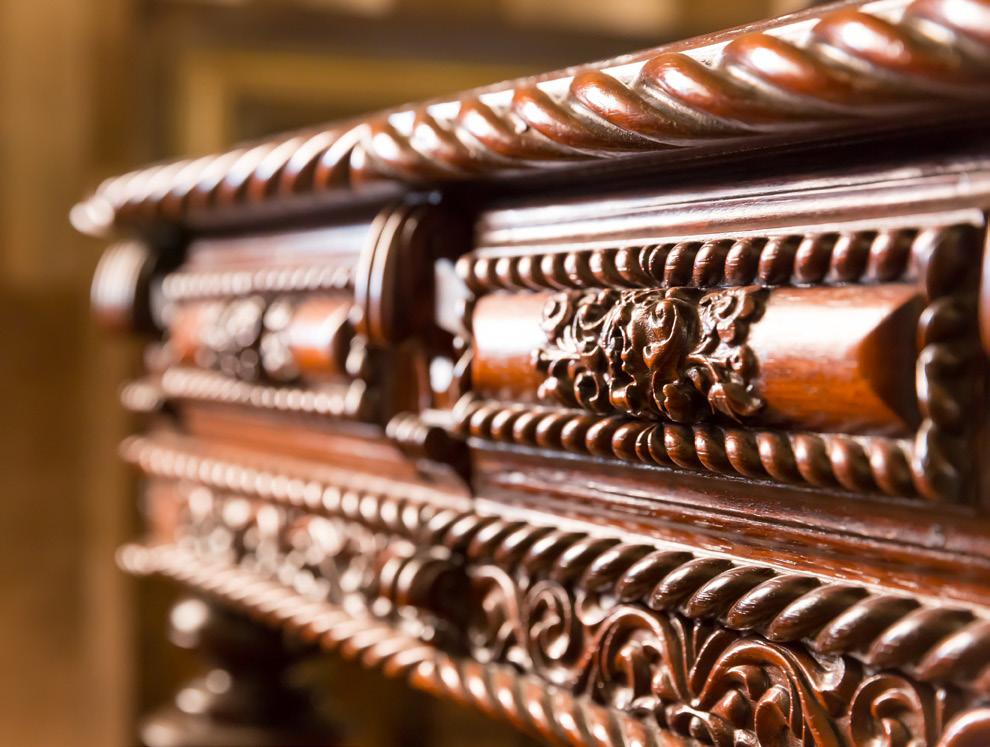
A number of special events are planned, including:
• Candlelight Ghost Tours and Dinner with the Spirits at Glenfield. Ghost tours are offered at 7:30 and 8:30 p.m. nightly during Fall Pilgrimage and include a complimentary beverage. Dinner with the Spirits is nightly beginning at 6:30 p.m. and includes a three-course meal and tour.
• Linden’s Mint Julep Cocktail Tour will be held Fridays Oct. 3, 10 and 17 from 4 to 5 p.m.
• Stone House plans Concert Tours on Fridays and Saturdays through Fall Pilgrimage beginning at 6 p.m.
• Sunnyside plans its Mourning Tour: The Wake of Annie Stuart beginning at 1:30 p.m. on Sept. 27.
South’s most mysterious mansion with the Ghost Tour of Longwood, an immersive nighttime experience through one of America’s most hauntingly beautiful homes. Also known “Nutt’s Folly,” Longwood s a towering octagonal mansion left eerily unfinished since 1861. By lantern light, guests are guided through the mansion’s richly furnished basement and into tales of sorrow, loss, and lingering spirits.
• Autumn Evening at Longwood. Saturday, Oct. 4, from 5:30 to 7:30 p.m. Includes a house tour, dinner in the Rotunda, live music, cocktails and a cemetery tour.
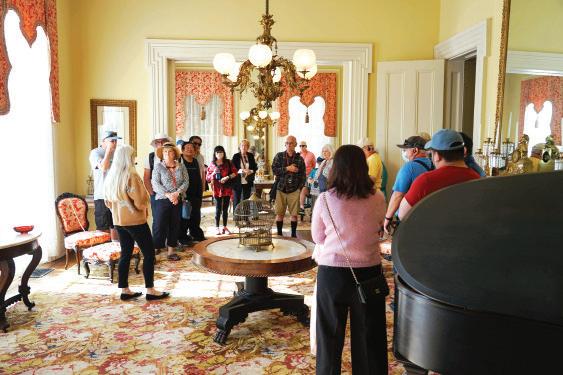
• Falling for Flavor: A Southern Dinner Stroll. Friday, Oct. 10. Begins with cocktails and appetizers at Myrtle Terrace. Salad, entree and cocktails will be served at the stately Stanton Hall, located just across the street from Myrtle Terrace. Then, the evening ends with dessert, cocktails and live music at The Big Muddy Inn, also located across the street from Stanton Hall.
• The Towers will offer a Twilight Tour on Fridays and Saturdays through Fall Pilgrimage, which includes light refreshments.
Pilgrimage Garden Club & Natchez Pilgrimage Tours
Fall Pilgrimage dates for the Pilgrimage Garden Club are Thursday, Friday and Saturday, Sept. 25-27, Oct. 2-4, and Oct. 10-12. Tours will be on rotation in the mornings and afternoons.

In addition to traditional historic house tours, the PGC is offering an abundance of events during Fall Pilgrimage to keep visitors entertained. Those include:
• Southern Sips and Splendor, Thursday, Sept. 25, from 5:30 to 7 p.m. at Stanton Hall. Appetizers, tour, cocktails, bourbon tasting on the back porch, live music and children dancing.
• Longwood Symposium: The River Nile to Natchez. Sunday, Oct. 12, beginning at 2 p.m. The Longwood Symposium will explore the layers of history, preservation and storytelling that make this unfinished octagon a living landmark. The first-of-its-kind program honors the vision of James McHenry Wade, former Longwood durator, and celebrates the people, objects and stories that continue to bring Longwood to life. Explore the adventurous journey of Dr. Rush Nutt and his son, Rittenhouse Nutt, down the Niles, his journals and how he ingeniously brought cotton seeds into the U.S. inside ostrich eggs — forever changing Southern agriculture. Speakers include Longwood Manager Dona-Marie Geoffrion; Marsha Colson, PGC president; Ruthie Coy, PGC executive board member; Beekeeper Violette Shepherd; Mimi Miller, executive director emerita of Historic Natchez Foundation; Joette Maroski, Longwood manager; and Dr. Terrel Williams, PGC president-elect.
Historic houses on tour include The Burn, Concord Quarters, Green Leaves, Lansdowne, Myrtle Terrace, Thomas Staniforth House, Dr. Bowman Banks House, Mount Repose, Elodie, White Wings, Casey Mallory Townhouse,
• Echoes of Longwood: Ghosts in the Octagon. Where history sleeps, but spirits don’t! Dates and Thursdays, Fridays and Saturdays from Sept. 25 through Oct. 31, each evening at 7 p.m. Step into the shadows of the
For tickets and more information on the Pilgrimage Garden Club’s Fall Pilgrimage 2025, visit https://natchezpilgrimage.com/ fall-pilgrimage-2025/ or call or visit Natchez Pilgrimage Tours, 211 Main St., Suite B, Natchez, 601-653-0919.














































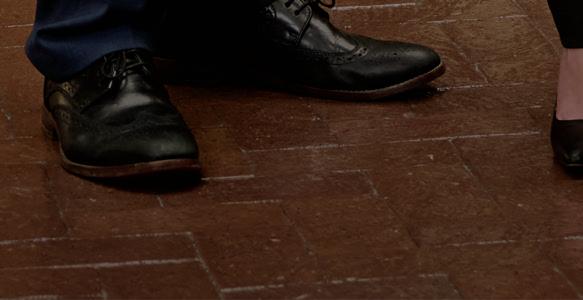



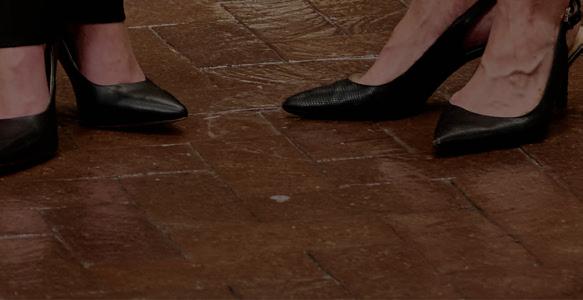

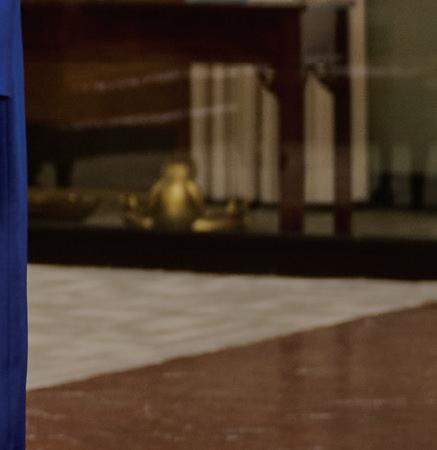

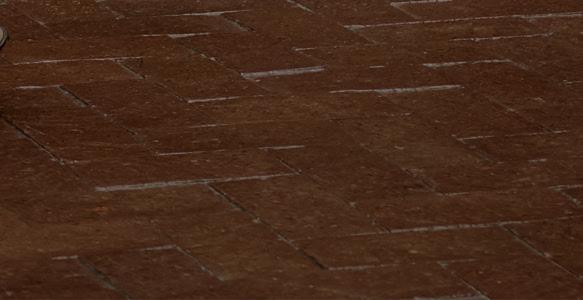


Concord Quarters is one of the two matching brick buildings that originally flanked the rear courtyard of Concord, which was arguably the grandest building of the colonial period (1716-1798).
Concord’s history is clouded with conflicting dates and ownership. Spanish legal records, 1790s correspondence, and an 1850 United States Supreme Court case confirm that Concord was built 1794-95 for Spanish Governor Manuel Gayoso de Lemos.
In 1794, Gayoso bought a tract of land about a mile and a half from Fort Rosalie “to build thereupon a house” and “to raise the commodities” to support a family. Desiring additional land for pasture, he successfully petitioned for a Spanish grant to enlarge his property to one thousand acres. The land purchased and granted in 1794 constituted the original Concord property.
In February 1795, Gayoso transferred ownership of the Concord
Choctaw Hall is the only mansion-style Natchez house built out to the street. The details of the interior are predominately Greek Revival, the massing of this monumental house is Federal and the giant Roman orders on the exterior, a Jeffersonian reference. This urban mansion transitions from Federal to Greek Revival, and showcases one of the finest collections of William IV and Early American Empire furniture, silver, and signed Jacob Petit Porcelain. Listed on the National Register of Historic Places as the Neibert-Fisk House, it was constructed in 1836 as the residence of the real estate speculator and developer Joseph Neibert.According to local tradition, Choctaw was designed and built by Natchez builder, James Hardie, a Scottish immigrant. Hardie and his three brothers, Alexander, John and William, were all employed in the building
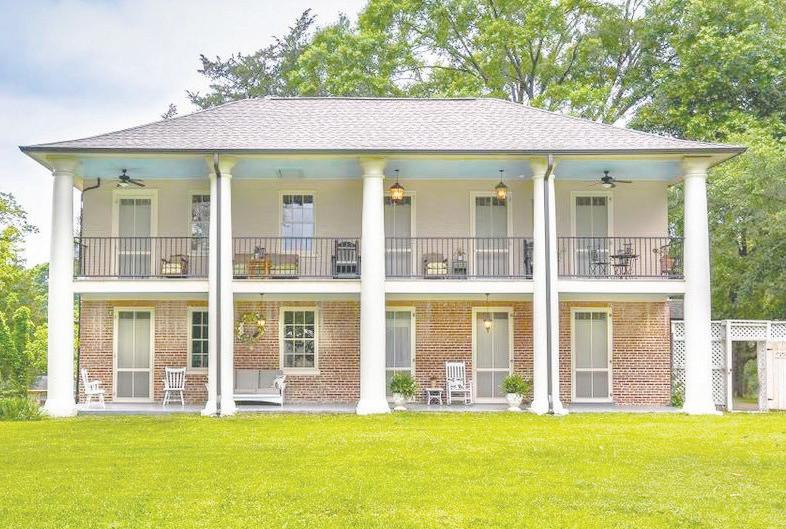
property to Margaret Watts, the sister of his deceased second wife.
He wrote a letter explaining his “connection” with Margaret Watts and related that they had signed a marriage contract and he had deeded her “an elegant country house.”
Gayoso’s contributions to Natchez have been lasting. He completed the platting of the grid plan of the town and drew a
line at Front Street (now Canal) and refused to grant land on the western side.
Instead, he created a public commons, or park, overlooking the Mississippi River. Until the late 1830s, the park extended from Canal Street to the edge of the bluff.
Manuel Gayoso’s widow sold Concord a month after his death, and it changed ownership twice
before Stephen Minor acquired the property in 1800 for $10,000.
Fifty years after the Minor family bought Concord in 1800, the U.S. Supreme Court affirmed the Minor family’s title to Concord.
Dr. Stephen Kelly bought Concord in 1890 from the Minor family and the house, which had become rental property, burned in 1901. Kelly’s son, George Malin Davis Kelly of Melrose, was still lamenting its loss in the 1940s. And what remains of Concord today? Still on the site and dating to the Minor occupancy are a small building whose original use is unknown and a two-story brick building with giant-order columns that originally served as quarters for enslaved servants.
Enlarged and remodeled as a residence earlier in the 20th century, the two-story brick building was recently bought and renovated by Gregory and Deborah Cosey.
The house is also operated as a bed and breakfast.
Corner of Wall and High Streets • Circa1836 • Home of David Gardner and R. Lee Glover
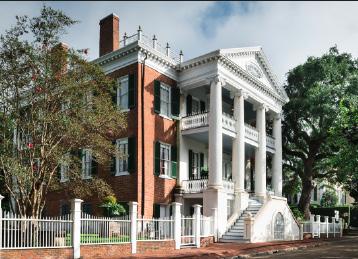
trade here. In 1844, Choctaw was sold to Alvarez Fisk, a commission merchant and philanthropist.
Fisk was instrumental in the establishment of the first public school in Natchez in 1845. And by 1855, the house changed hands again, becoming the residence of
George Malin Davis, who would eventually own Melrose, Cherokee and Concord as well. For a brief period at the turn of the 20th century, Choctaw even housed the all-female Stanton College. The mansion then came into ownership of the City of Natchez.
The city purchased the property in 1937, when the house was meticulously restored between 1939 and 1942 by the Works Progress Administration, (WPA) The city built the City Auditorium on part of the site in 1940. In 1978, fire damaged the first floors, and it sat unrestored for many years until in 1989 businessman Don dePriest purchased the mansion from the city in 1989 and did another full restoration.
Today, the house is owned by business partners David Garner and R. Lee Glover who have completed the homes restoration and preservation journey and have appointed the home with the highest end elegant and luxurious 19th century furnishings and decorative art, and enhancing the site further with beautiful gardens making it by far one of the most opulent and must-see homes in the entire South.
Dunleith is one of the most picturesque and stately homes in the Natchez vicinity. It stands on the site originally occupied by a house named Routhland, which was built by Job Routh and his wife, Ann Miller, during the late 18th century.
Alfred Vidal Davis purchased the house for $30,000 in 1859. Mr. Davis is responsible for erecting the existing wrought iron fence, which cost $1,800. He also is responsible for changing the name of the house to Dunleith, a Scottish name.
In 1886, Joseph Carpenter, a prominent local banker, purchased Dunleith, and it remained in the Carpenter family for the next 90 years. During their ownership, Dunleith played host to some of the most lavish social gatherings in Natchez, if not in the South.
The Carpenter family’s presence still is evident today, as daughters etched their names in the window
Step into history at Elodie, an architectural and cultural gem nestled in the heart of the Natchez Garden District. Visiting Elodie is akin to stepping into a national museum, where every room tells a story and every artifact whispers the past. This extraordinary home is a treasure trove of Natchez Pilgrimage history, offering an immersive experience like no other.
Elodie is not just a house; it is a living testament to the deep-rooted history of Natchez. Home to the great-niece of Katherine Grafton Miller, the visionary who pioneered cultural tourism in the region, Elodie carries on a proud legacy of preservation and storytelling. But the familial connections don’t stop there—this home also holds rare and invaluable historical artifacts that connect visitors directly to the city’s most iconic moments.
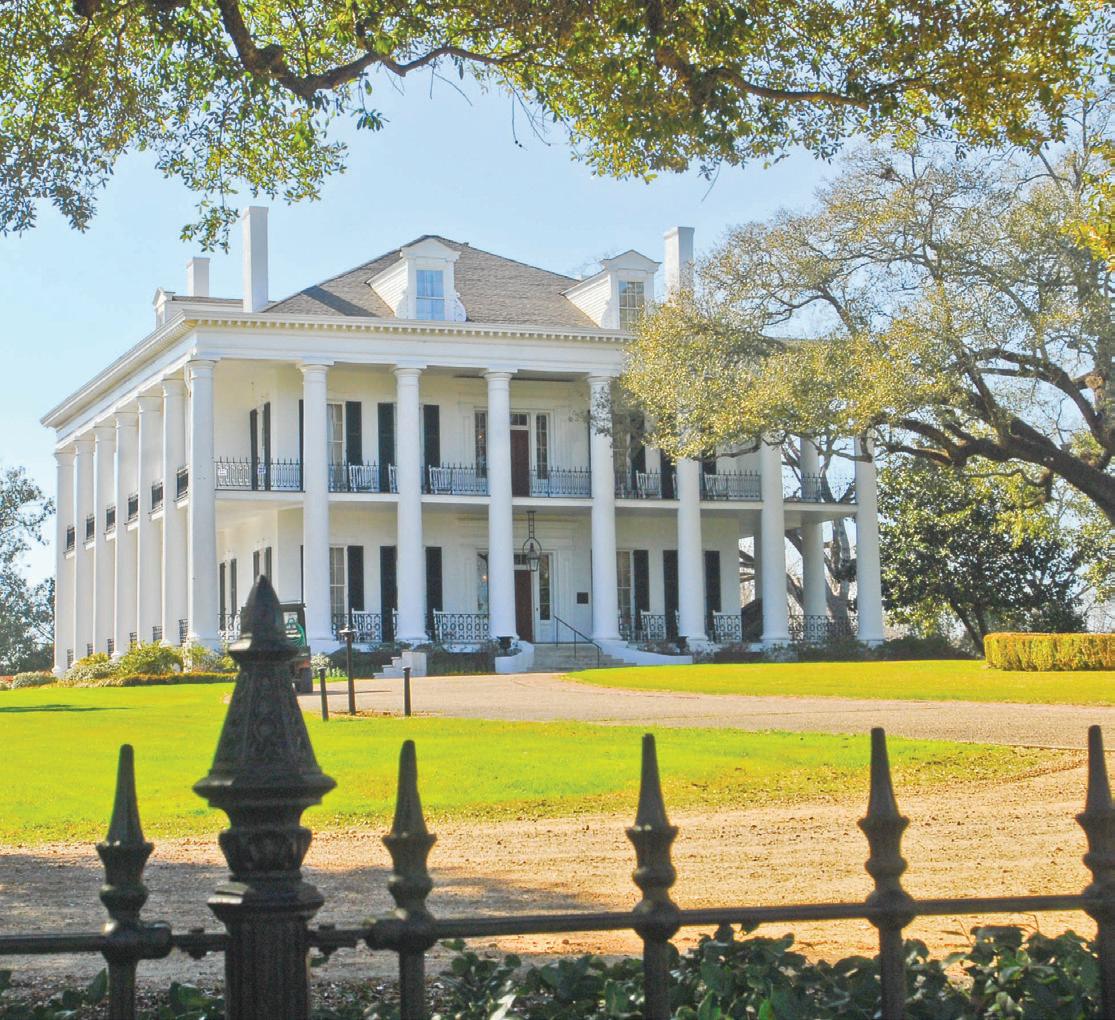
panes. The custom was to make such etchings with the engagement diamond. Dunleith is set upon 40 acres of land directly in the
include
evident in the architectural details of Dunleith. Among those details, the most prominent are the 26 Tuscan columns surrounding the house. Dunleith is the last example of a fully colonnaded house standing in Mississippi.
The brick and stucco columns that surround the house support a double gallery. Intricately designed wrought iron railings span the length between each column. The interior of Dunleith is equally as grand, comprising 9,500 square feet of floor space.
The floors are made of heart pine. Adorning each fireplace is an Italian marble mantelpiece. Although made of cypress, the baseboards on the first floor are painted to look like oak. The technique used to achieve this look is known as faux bois.
The property isoperated yearround as a tour home, historic inn and event venue. The grounds are also home to the Castle restaurant.

Inside Elodie, you will witness firsthand a collection that few places in the country can rival:
• The original portrait of Thomas Rose, the master architect and builder of Stanton Hall, one of Natchez’s most celebrated architectural masterpieces.
• The original design book used
by Thomas Rose, containing the blueprints that shaped the grandeur of Stanton Hall.
• A collection of historical documents signed by Abraham Lincoln, a window into the thoughts and actions of one of America’s most revered leaders.
• The sword of Spanish Colonial
Governor Manuel Gayoso de Lemos, a rare artifact that echoes the Spanish influence on Natchez.
• Countless other historical treasures that bring the past to life.
Every corner of Elodie is a tribute to history, architecture, and culture. As you walk through its grand rooms, you will not only admire its beauty but also gain a deeper understanding of the figures who shaped Natchez and beyond. From architectural blueprints to personal relics of influential leaders, Elodie offers a rare opportunity to step back in time and witness history firsthand.
For those who cherish history, architecture, and the stories that bind generations together, Elodie is a must-visit destination. Come explore this magnificent home, where the past is preserved, and the legacy of Natchez continues to thrive.
Built in 1836 for William St. John Elliot. D’Evereux is one of the first residential structure constructed in Natchez with a full-length monumental, two-story portico; the white columned look that would be stereotyped as southern architecture in later years. D’Evereux also marks the first appearance of a cupola in Natchez residential architecture. Although some changes have occurred to the interior, it is still generally original and intact. According to the National Register nomination form, “Perfection of proportion and academic rendering of its structural and decorative detail make D’Evereux one of the outstanding examples of the Greek Revival style.”
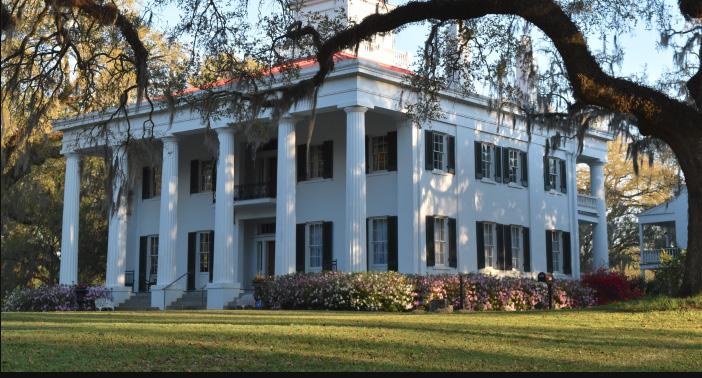
Uncover captivating history at Glenfield, a stunning former plantation home known as Glencannon. Just one and a half miles from downtown Natchez, this southern gem is more than just a beautiful residence - it’s a window into the past, with images of a diary from the 16-year-old resident during the Civil War, which is currently on display at the Maryland Historical Society.
This impressive home still occupies 150 acres of the original 500-acre British land grant, deeded by the Crown in 1774. The home is a unique blend of two distinct architectural periods, making it a true time capsule that transports visitors back to a bygone era. Upon arrival, visitors may be deceivingly struck by the small front appearance of the one-story home, but once inside, you’ll be captivated as you tour two distinct architectural periods. The earliest standing structure is the Spanish architecture portion of the home, built in 1817 by Charles B. Green for his wife Helen Andres Girrault.
The four rooms and stone gallery boast breathtaking views of the patio and lush landscape, and are true to the construction techniques of the time period. The walls are a formidable 17 inches thick and built directly into the ground, and the low ceilings are 8.5 feet high with small, heavily shuttered windows designed to ward off the prowling animals that
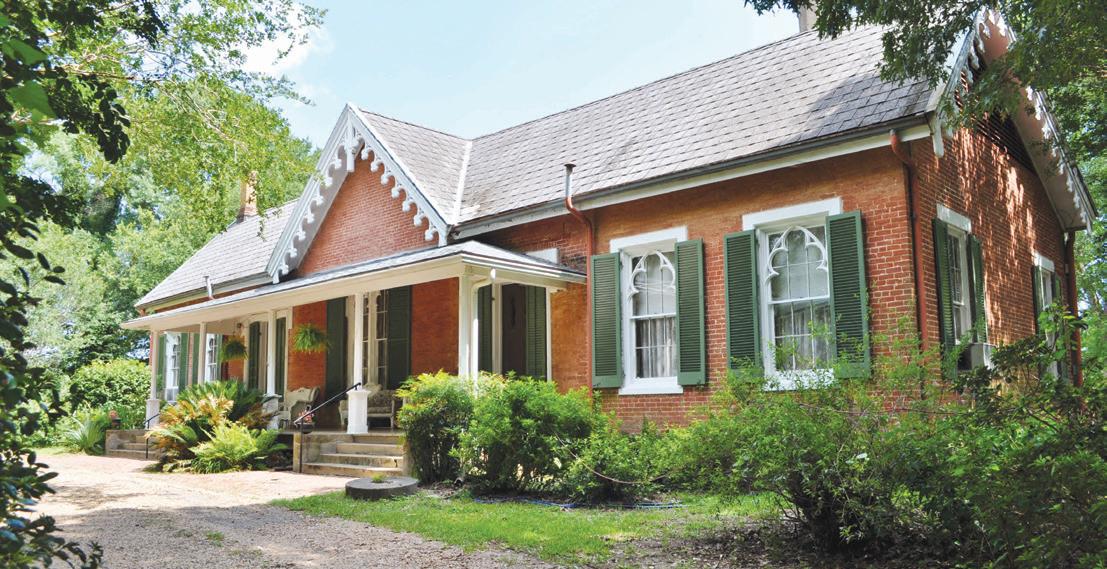
roamed the Natchez settlement in its early days. In 1845, wealthy ScotchIrish attorney John McDonnell purchased the property and added the grand English Gothic addition. This addition showcases McDonnell’s grandeur and affluence for his bride. Glenfield remains the only full residential home in Natchez featuring English Gothic architecture, and one of only ten in the State of Mississippi. Due to the untimely death of Mrs. McDonnell, the property was sold to the Cannon family who renamed it Glencannon.
The large parlor is adorned with twin passageways, and a beautiful Gothic window with heavy handmade blinds that takes center stage. The ceilings are a towering 15 feet tall, and the impressive marble mantels, which can be found in the sitting room and the dining room, are imported from Italy. The dining room, once located in the south wing, was moved for safety
reasons when Union soldiers’ set up an encampment on the property to guard the picket lines. The dining room features a stunning family collection of china, crystal, and silver. The room’s two large windows boast hand-blown glass panes that rise up into the upper walls to the ceiling, held in place by rope and weights built inside the casing frame.
As visitors move through the rooms, they will notice the original doorknobs and doors and the intentional preservation of original paint in two rooms.
The hand-carved window cornices, hand-made from teakwood, were designed to represent the family crest of the Cannon family. A unique window in the parlor that opens to the fainting hall was built to provide ventilation during the humid southern temperatures. The home is filled with stately antiques and unique original furnishings that grace the rooms.
The home’s original Louisiana
Cypress floors are another breathtaking feature, with some 30-foot solid boards remaining in one long piece, wall to wall. During the ownership of the Cannon family, the plantation was home to cotton crops, a two-story carriage house, a separate two-story kitchen and laundry building, three cisterns, two slave quarters, two barns, two lakes, a dairy house, and many other outbuildings typical of a plantation home of the time. Although the outbuildings and lakes are long gone, sketches and photographs are on display to give visitors a glimpse into the former glory of the property.
One of the most cherished pieces is the sketchbook and diary images on display from Lucy A. Cannon, the 16-year-old daughter of William and Jane Shipp Cannon. Lucy documented her family’s daily life at Glencannon from April 1864 to March 1865, when Natchez was under Federal occupation.
Her diary offers a glimpse into life just outside the picket lines during the Civil War. Witness the bullet scars left by an attempt from Union soldiers to invade the home.
Today, Glenfield is owned by Mrs. Marjorie Field Meng, the fourth-generation owner, and is listed on both the National Register of Historic Places and as a State of Mississippi Landmark.
The home was featured on the original Spring Pilgrimage,
Green Leaves is best rec nized as one of the most valuable national documents of mid-nineteenth century taste in the South, with its remarkable and extensive preserved memorabilia and furnishings. The interior is notable for both its original integrity and includes many period architectural features, along with period decorative arts and contents which together make it one of the most significant historic interiors in Natchez.
The carpet, wallpaper and rosewood and mahogany furniture have not been changed since the early 1850s. Of particular note, throughout the home sports Cornelius, Baker, and Company light fixtures and chandeliers, original gasoliers from one of the most prestigious lighting companies of the era, they remain intact and electrified.
Perhaps no house in Natchez is more suitably named than Green Leaves, it has been occupied since 1849 by six generations of the Koontz-Beltzhoover family since George Washington Koontz came to Natchez from Washington, Pa., in

1836 at the age of 20.
The name was inspired by Lyle Saxon, author of several books about the Deep South. In the 1920s, when the late Ruth Audley Beltzhoover was president of the local garden club, Saxon was in Natchez getting material for his book, “Old Louisiana.” He asked to see Mrs. Beltzhoover’s gardens. When she said, “It is only a garden of green leaves,” his reply was so eloquent that she named the home Green Leaves.
One of the most important and historically intact homes in Natchez., still owned and occupied by the descendants of the original builder. It contains most of the original furnishings and its decorative finishes including the original French scenic Zuber wallpaper are intact. The rare interior has been carefully preserved for over 160 years.
Designed in the Georgian Revival. The exterior is deceiving, given the scale of the rooms once inside, you enter into a 65-foot long center hall. The great size gives it a more extravagant feel than is found even in many of the larger Natchez mansions.
To the left of the hallway is a spacious drawing room with an exquisite white marble mantel carved in a calla lily design. Behind the mantel is a large mirror in an Adams frame; resting on the mantel
Appropriately, the house is set in the midst of live oaks, magnolia, cypress, azaleas and camellias. The 400-year-old oak in the rear courtyard spreads a canopy of living green over the grounds.
This National Register home was built by E.P. Fourniquet in 1838 at the then exorbitant cost of $25,000 and further embellished by George W. Koontz in the mid-19th century. A raised cottage, it is approached from Rankin Street by two flights of
steep steps.
On each side of the front columned porch are wings with lacy iron balconies, added by Koontz. The stately front door of cypress is set in a monumental frame with Corinthian pilasters on each side. The sidelights are of alternating circular and diamond-shaped panels.
Across the rear of Green Leaves is a wide gallery with large columns and banisters. The rooms on the back all open by jib windows onto the gallery.
Forming the rear courtyard are the bedroom wing added by Koontz and the two-story brick kitchen building, which in the 19th century was joined to the house by a covered passageway.
Soon after George Koontz arrived in Natchez he became affiliated with William Britton and, in time, he became president of the Britton & Koontz Bank. In 1845, he married Mary Roane Beltzhoover who became parents to eight children, whose descendants still live at Green Leaves.
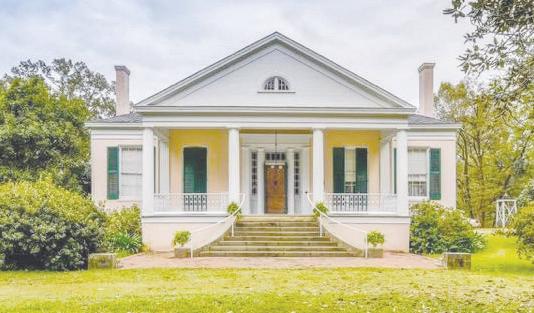
is a Sevres clock and two matching urn-like ornaments, all under glass domes. The front parlor contains one of the most complete and well-preserved Rococo Revival style interiors in Mississippi from the era.
Over the windows are gold leaf cornices from which hang replicas of the original lambrequin window
coverings. The original rare and delicate artifacts were donated to the decorative arts collections of the Cooper-Hewitt Museum in New York, a branch of the Smithsonian. The walls still display the original hand-blocked French Zuber wallpaper. The house contains Cornelius and Baker of Philadelphia bronze chandelier gasoliers,
originally fitted and supplied by a gas plant built on the grounds of Lansdowne.
Being in the same family since 1853, the house has many layers of heirlooms and furnishings. The bedrooms of Lansdowne are quite large. The front bedroom is furnished with an original set of large, hand-carved rosewood furniture made by Prudent Mallard of New Orleans.
At the rear of the house is a large brick courtyard. On opposite sides of this courtyard are two brick dependencies, each two-story, which originally contained the kitchen, washroom and enslaved servants’ rooms in one, and a large billiard room, office, schoolroom and governess’ quarters in the other. Lansdowne is truly a mustsee property, a private home it also offers Bed & Breakfast accommodations.
Political posturing…a Spanish land grant…West Indies architectural flair wedded to sophisticated Federalist influence…glory days to destitution to resurrection—all these inform the history and heritage of the House on Ellicott’s Hill. To Natchez established in 1716 as the oldest city on the Mississippi River, President George Washington in 1797 by rights granted in a 1795 treaty with Spain, sent Major Andrew Ellicott and his regiment to raise the first American flag in the Mississippi Territory. Ellicott’s bold stance on this highest hill of the fledgling town, a straight shot north and fully visible from the Spanish Fort Rosalie, put the entrenched Spanish forces on notice that the United States had staunchly claimed its own. To this day atop Ellicott’s Hill, Old Glory flourishes its fifteen-star 1797 finery. Also in 1797, wealthy merchant-planter James Moore purchased this hilly lot on the street then closest to the river bluff, an area reserved by Spanish city plans for the homes of the most prominent and wealthiest Natchez citizens. Constructed between 1797

and 1801, Moore’s expansive town home, built into the side of the hill, enjoyed a commanding view of the Spanish park and promenade immediately below, of the adjacent bluff area framing the venerable Mississippi River with its splendid sunsets, and of the vast lands beyond awaiting their impending Louisiana Purchase.
Most impressive about the exterior of this brick basement story and its upper wood-framed main floor, are the home’s West Indies-inspired distinctive high-pitched vernacular shed roof and august yet graceful upper and lower front galleries. Most intriguing is the home’s posterior dry moat, creating
The Dr. John Bowman Banks Museum, also known as The John Banks House, was the home of Natchez’s first black physician and a hub of the Civil Rights Movement in the 1960s.
Established in 2020, the museum offers a perspective of Natchez’s history that includes community life during the early 20th century and the Civil Rights Movement during the 1960s.
Dr. John Bowman Banks (1862 -1911) began practicing medicine in Natchez in 1889. He later recruited the city’s second African American doctor, Albert Woods Dumas, and together they founded the Bluff City Savings Bank, the
passage, light, and air flow behind and around the lower story and necessitating short bridges from the upper story to the top of the adjacent hill. The elegance of the era’s fashionable Federalist architecture appears in the home’s millwork, fanlighted front and rear doorways on the main floor, and domed and vaulted ceilings.
From its early laurels as one of the two most valued properties in early eighteenth-century Natchez, the House on Ellicott’s Hill, as eventually designated, faced a motley future as rental property, a boys’ high school, perhaps a coffee house or tavern (hence its earlier designation as Connelly’s Tavern,)
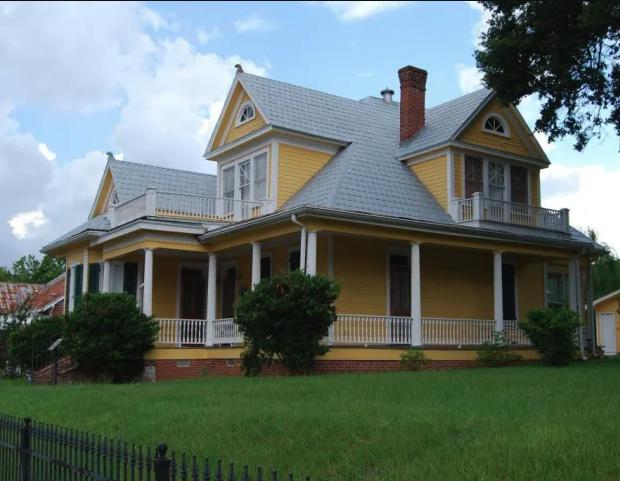
and a residence for workers at local cotton mills from the 1870s to the 1920s. In 1934, when bought by the Natchez Garden Club—the first organization to purchase and restore a historic home in Mississippi—this once-heralded site appeared a dilapidated, hopeless cause. However, with its architectural integrity still intact and under the guidance of New Orleans architects from 1935 to 1937, the garden club restored the home to the glory of it prestigious origin, thereby modeling restoration and preservation endeavors for hundreds of statewide historic homes thereafter.
In 1976, following a change in The Natchez Garden Club’s charter, the Preservation Society of Ellicott’s Hill assumed ownership of the House on Ellicott’s Hill and in 2006 completed a more recent and researched renovation of the home. In 1974 and 2001, respectively, this distinguished structure acquired long-merited status as a National Historic Landmark and a Mississippi Landmark. Today, the House on Ellicott’s Hill is Natchez’s oldest surviving territorial-period building.
only African American-owned bank in the city at that time.
During the 1960s, the house served as the headquarters for the NAACP. Charles Evers, who served as the Mississippi NAACP Field Director, used the Banks House as a hub for the civil rights movement in Natchez. Evers was the brother of slain civil rights leader Medgar Evers.
Today, the museum exists to educate and inspire, while telling the full story about an important piece of Natchez’s history. Visit the Dr. John Banks House today and experience this important journey through time.
On the outskirts of Natchez, deep among forest trees heavy with Spanish moss, stands the largest and most captivating octagonal house in America, the “Oriental Villa” called Longwood.
Planned in 1859 for cotton nabob Haller Nutt and his wife, Julia, by Philadelphia’s distinguished architect Samuel Sloan, the mansion was begun in 1860.
Using the octagon form with four main floors, a fifth-story solarium and a sixth-story observatory, the structure was designed to have 32 rooms, each with its own entrance onto a balcony.
Inside, as a core to provide ventilation and light, was a great rotunda open to the clerestory six floors above.
On the main or principal floor were to be eight rooms, including a drawing room, banquet hall, library, reception room and a special apartment for Mrs. Nutt. Connecting the levels was to be a grand spiral staircase.
Crowning the whole was a Byzantine-Moorish dome with a 24-
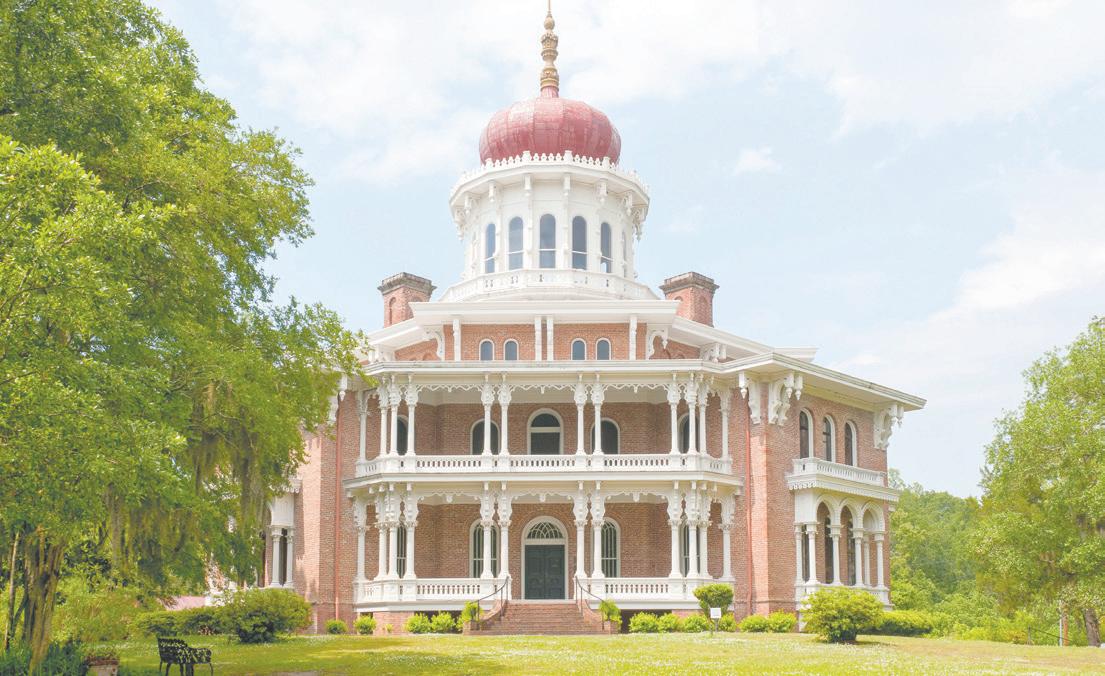
foot finialy reaching heavenward. The lavish exterior was to be only a hint of the magnificence foreseen in the interior.
Work progressed rapidly, and when the gigantic shell was up, the exultant Mr. Nutt wrote to Sloan, “It is creating much admiration,” and proudly predicted that “after this the Octagon will be the style!”
In April 1861, all his hopes and dreams were smashed by the declaration of the war.
Sloan’s Philadelphia craftsmen dropped their saws and hammers
Monmouth Historic Inn is an early 19th century 1818 antebellum mansion set on 26 acres of manicured gardens.
The powerful example of Greek Revival architecture is a National Historic Landmark and was once owned by John Quitman, Marine general, military hero, and governor of Mississippi.
Monmouth evolved from rough timber, mortar, nails and brick to a stately antebellum, suburban villa built from the labor of human hands both free and enslaved. Over the span of more than 190 years of existence, Monmouth witnessed generations of births and deaths as the home and workplace of slaves, tenant farmers, American statesmen, businessmen and enterprising housewives, all contributing to its historic saga as one generation passed from view and the next took its place.
John Quitman was Monmouth’s most prominent occupant. Arriv-
but legend insists that he died of a broken heart over his dream house.
Julia and the children lived on in the cellar doing only a minimum to maintain the great hulk looming over them. She died in 1897 and was buried beside her husband in the Longwood family cemetery.
Grandchildren owned Longwood until 1968.
Today it is maintained, yet unfinished, by the Pilgrimage Garden Club.
and fled North to pick up rifles and bayonets, never to return.
Dejectedly, Nutt and a few local workers completed the basement level. This area, where a wine cellar, school room, recreation room and office were to have been, was converted into living quarters for the Nutts and their eight children. Here they lived in nine rooms as war swirled across the South.
On June 15, 1864, Haller Nutt died in the basement of his unfinished mansion.
The diagnosis was pneumonia,
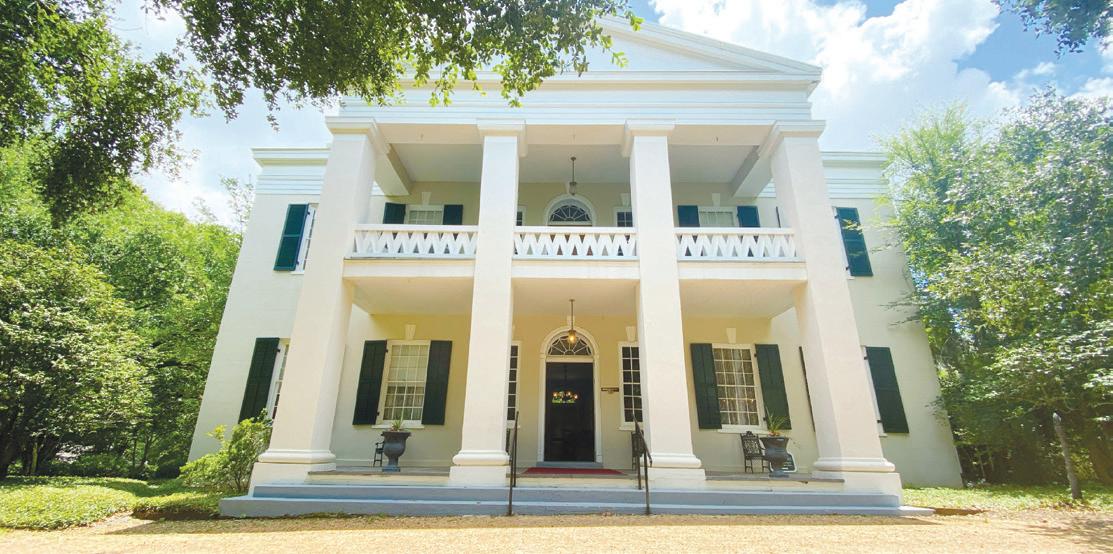
ing in Natchez as a penniless newly minted lawyer, he soon married into one of the area’s most prominent families and went on to a partnership in the town’s most successful law firm. During his life, he gained national attention as a conquering general and military hero in the nation’s war with Mexico. He also served as governor of the state and in the Mississippi state legislature and the U.S. Congress.
Quitman died at Monmouth on July 17, 1858, apparently a victim of
what was then called the National Hotel Disease, an ailment similar to Legionnaire’s Disease, which many American politicians contracted after staying or dining at the National Hotel in Washington, D.C. Forty-nine year old Eliza, a widow with several underage children, and multiple Monmouth household obligations, assumed stewardship of four plantations and the hundreds of enslaved individuals. This great responsibility, however, was short lived. In 1859, Monmouth’s
The average visitor will ask, “Why not finish it now?”
The answer comes, “No, leave it as a monument to the heart-rending break of the War Between the States. Let it mark the end of an era.”
Longwood, located on Lower Woodville Road, was described as “a remembrancer of Eastern magnificence” by its architect in 1861.
Longwood has been designated a National Historic Landmark, a Mississippi Landmark and a historic site on the Civil War Discovery Trail.
matriarch Eliza Turner Quitman died and was buried next to her husband at Monmouth. Quitman daughters would later move their parents to the city cemetery north of town. With the coming of the Civil War to Natchez, Monmouth experienced the plight of numerous southern estate villas when once wealthy owners could no longer afford the trappings of the elite. Over the years after the Civil War, Monmouth continued to fall into terrible disrepair.
Although Monmouth was once a grand estate, embellished with the finest furnishings and landscaped gardens, 20th century Monmouth saw not only the decline of the estate and its grounds, but the scattering of many of its prized furnishings. In 1978, the home was purchased and restored to the 1830s period; many pieces found in the house were discovered to be original Quitman pieces. Today, the historic renovation of Monmouth continues under owners Nancy and Warren Reuther.
Magnolia Hall is an imposing home in the Greek Revival style. It has been restored in recent years to a historically accurate exterior. One of the most beautiful ceiling medallion designs in all of Natchez, with arabesques of magnolia leaves and blossoms incorporated into their design. Magnolia Hall derives its name from these spectacular decorative works of art, and they are not to be missed.
As one of the finest examples of Greek Revival style in Natchez, the house features a hooded doorway and a well-proportioned portico with massive Ionic columns. The upper deck of the portico is enclosed with wrought-iron banisters. Henderson had his new brick house stuccoed, painted brown and scored to imitate the brownstone so popular in the northeast at the time. The lower floor of the main structure contains six rooms, including a library, double drawing rooms, a banquet hall, a private sitting room and a bedroom. The wide hall is lofty and has a mahogany-railed stair leading to the upper floor, where there are six more large rooms.
Built in 1858 by Thomas Hen-
The tranquility of the seven-acre park-like setting at Linden is captivating. The grounds on which Linden stand was originally part of a Spanish land grant dating back to 1780.
Linden was built by James Moore as a four-room cottage on land he inherited from his father, Alexander Moore in 1790. Thomas A. Reed, one of the first U.S. Senators from Mississippi, acquired the property in 1818 through his wife, Margaret Ross, who inherited it from her father, Isaac Ross. Margaret and Thomas Reed changed the name to Reedland.
Dr. John Ker purchased Reedland in 1818 after Thomas Reed’s death and changed the name to Linden. The Linden name references the national tree of Germany, which was his family’s native country, and it has been known by this name ever since.
Mrs. Jane Gustine Conner purchased Linden from Dr. Ker in 1849
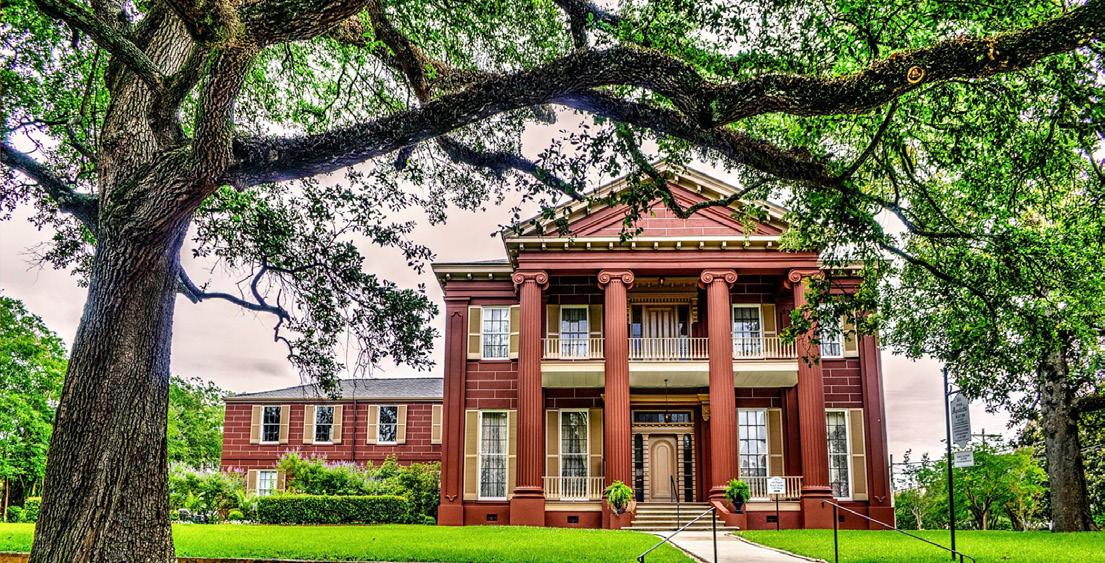
derson, a 60-year-old widower at the time and a wealthy planter, merchant and cotton broker. The Henderson’s were a prominent pioneer family. Thomas Henderson’s father, John, had left his native Scotland in 1770. He owned numerous plantations in the Natchez region, wrote the first book published in the Natchez Territory and helped found the Presbyterian Church in Natchez in 1807.
Magnolia Hall is the last grand Natchez house completed before the American Civil War. In 1853 Thomas Henderson had been elected vice-president of the American Colonization Society, though Thomas’ two sons fought for the Confederacy. During the Civil War, Magnolia Hall was
damaged by the Union gunboat Essex, which bombarded the town from the Mississippi River several blocks west. A shell from the boat struck the service wing of the house. The damage was slight, and no one in the home was injured.
Thomas Henderson died before the war ended and shortly thereafter the house was sold to the Britton family, who occupied it for many years. Fortunately, an inventory of the furnishings of the Henderson family had been made to settle Thomas’ estate, giving future owners an exact idea of what it contained.
Unfortunately, the house became a rooming house and private Episcopal school in later years, and it was during this time
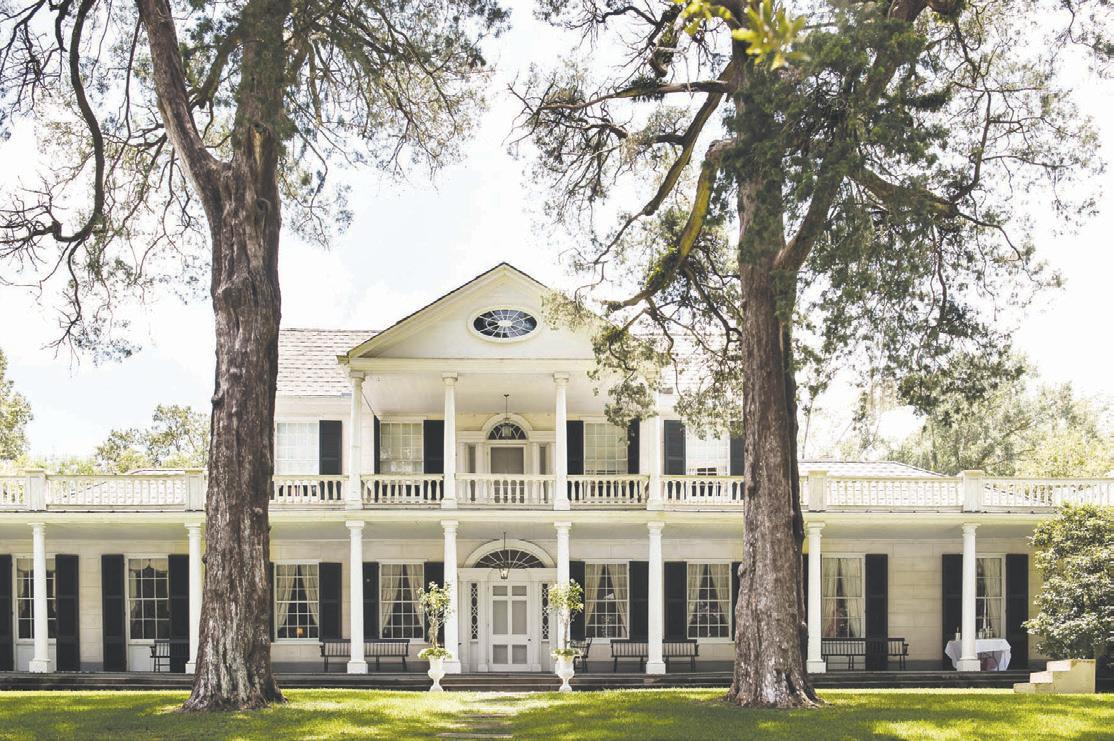
after her husband, William Conner died. It was there that she reared ten children and three grandchildren. During the Civil War, Mrs. Conner became known locally as the “Little War Mother”, as five sons and three sons-in-law headed off to battle. Linden has remained in the family for six generations, and is presently owned by Marjorie Feltus Hawkins, whose birthday is interestingly the
all of the original partition walls were removed, all but two of the original mantelpieces were sold, the ceilings were lowered, the original chandeliers were sold and the home became institutional in character. Then in 1976 the house was saved by the deeding it as a gift to the Preservation Society of Ellicott Hill, the preservation arm of the Natchez Garden Club, by Mrs. George Armstrong of Fort Worth, Texas, and Woodstock Plantation in Adams County.
During the years following its acquisition, the Natchez Garden Club completed a restoration of the house under the direction of New Orleans architectural firm Koch and Wilson and of the Mississippi Department of Archives and History. Magnolia Hall is owned and maintained by the Natchez Garden Club, which in the 1930s began a movement to restore, preserve and promote the historic homes of Natchez. The club has acquired many of the original Henderson furnishings and artifacts. The mansion also houses a costumes collection of past Pilgrimage dresses, and a doll collection. gift shop.
Gustine Conner, October 30th.
As one of the earliest homes in Natchez, Linden doubled in size between 1818 and 1849 as additions were added and more land was acquired.
During this time one-story extensions were added to the original house, the 98-foot front porch, and the notable front doorway.
The doorway is an architectural triumph of inlay and alternating diamond and oval panes, for which it is said inspired the front door of Tara in “Gone With The Wind”. The second-story front porch was then added to the central portion of the house with a light and graceful pediment complete with an oval window.
The front door opens into a beautiful hallway with a staircase to the second floor. The downstairs floor plan is elegant in its simplicity, with large rooms opening into one another.
Fine antique lovers will not want to miss seeing this home, as Linden is furnished with an important and remarkable collection of American furniture of the Federal period. Sheraton, Hepplewhite, and Chippendale furnishings fill the home. Truly a museum-quality collection, visitors will enjoy seeing firsthand how furnishings of the era were meant to be used and displayed.
This welcoming home was built by Nathaniel L. Carpenter beginning in 1844 and completed in 1851 when purchased by steamboat captain, Thomas P. Leathers. Today the home showcases a gorgeous collection of Empire and Victorian furnishings within the walls of its spacious yet homey rooms. The mid-nineteenth century furnishings that you see are appropriate for the early life of the home.
Although Nathaniel L. Carpenter came to Natchez as a builder, no building other than Myrtle Terrace has been documented as having been built by him.
The house is a good example of transitional architecture with the earlier Federal Style surviving in the delicately runed columns and the later Greek Revival Style employed in the entrance and interior millwork. The interior plan is. A double-pile plan, two rooms deep, with a center hallway. The second story was originally accessed through an enclosed stairway entered from the rear gallery. Mr. and Mrs. Butler who owned the home beginning in 1942 installed the present stairway. The second story of the house contains

A small basement room is located beneath the rear sitting room of the first story. Modern additions to the home were added by the Durkin family in approximately 1979. Camille Durkin inherited the home from her parents, the Butlers, and the home was purchased by James C. Johnson and Geoffrey Butcher in 2018.
Myrtle Terrace is historically known as the home of Captain
Built in 1854, the Thomas Staniforth House is a classic Greek revival brick cottage. Thomas Staniforth, its builder, was a Natchez contractor / builder who lavished extra attention on what was a comparatively modest house for the time and neighborhood, probably because it served to advertise his business. Original casings highlight the large windows across the front, and fireplaces grace several rooms.
Large antique salvaged windows have been added to the kitchen, providing a lovely view across the back gallery and walled garden. Other particularly attractive touches are the decorative painted paneling restored in the dining room and the faux stone walls in the entrance hall. Beautiful cypress cabinets complete the kitchen.
P. Leathers, who was internationally known as a famous steamboat captain. He was born in Kentucky in 1816 and began his river career on the Yazoo River in 1836. He had great financial success in the lower river cotton trade and built many steamboats, among them seven named “Natchez.” A frequently told story is the legendary steamboat race in 1870 between the Natchez, captained by Leathers, and the Robert E. Lee, whose captain
was John W. Cannon. After retiring to New Orleans, Leathers died at the age of 80 after having been r un over by a hit-and-run bicyclist, thus ending one of the most successful careers in steamboat history. Another important person in the Natchez community who lived in this home was John Hunter, who was mayor in 1962 when the naval forces of the U.S. demanded the surrender of the city.
The home has a beautiful garden with fountains surrounded by an ornate iron fence.
Behind the house is a carriage house built in the 1850s that is now used as an Airbnb.
The house on the other side of the driveway was once on the property and housed the help. It was moved to its present location sometime between 1910 and 1925. The three-car garage was built sometime between 1925 and 1943.
Harnett T. Kane once described Myrtle Terrace as “a smell gem in the town of Natchez, almost a baby-scaled version of the plantation time … (it) has the charm of the diminutive and the restrained – everything the. Captain was not.”

MMount Repose was built in 1824 for William Bisland, on lands granted his father, John Bisland, by the Spanish Crown in 1782. It has been listed on the National Register of Historic Places since 1979. Originally constructed in the Federal style in 1824, Mount Repose was a 2 1/2 story single-pile house with central hall. The columns, six above and six below, are unrelieved in their simplicity, and two side wings can be seen to the left and right. The strong lines of the heavy chimneys provide a further interesting touch.
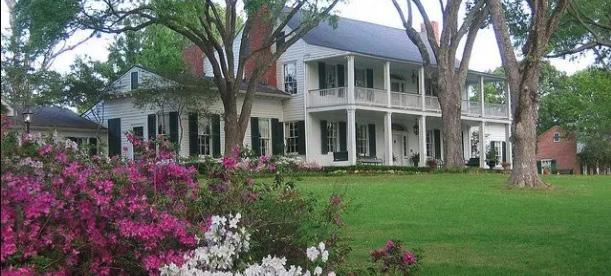
White Wings was built between 1833 and 1835 as the home of Sarah Robinson. It was originally a simple late Federal cottage with small portico. After her death in 1853, the house was acquired by Charles Meeks, a native of New York. Meeks was a banker in Natchez and was engaged in the grocery business at the time of his death. Meeks owned the house from 1854 until he died in 1902, during which time he made two major enlargements. Between 1864 and 1886, Meeks added an addition with master bedroom at the rear and between 1892 and 1894, another bedroom with bay window was added. The wing additions to the house were the source of the name White Wings.
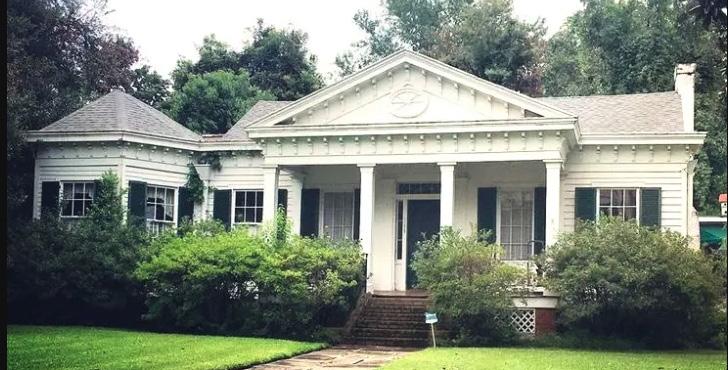
The grandest extant townhouse built on a commercial street in our historic district is the Casey Mallory Townhouse. The fine, high-quality brickwork, laid in an all-stretcher bond with narrow mortar joints, of the facade is attributed to Philadelphia brick mason, John C. Fox. The interior of the home features fine furnishings and decorative arts.
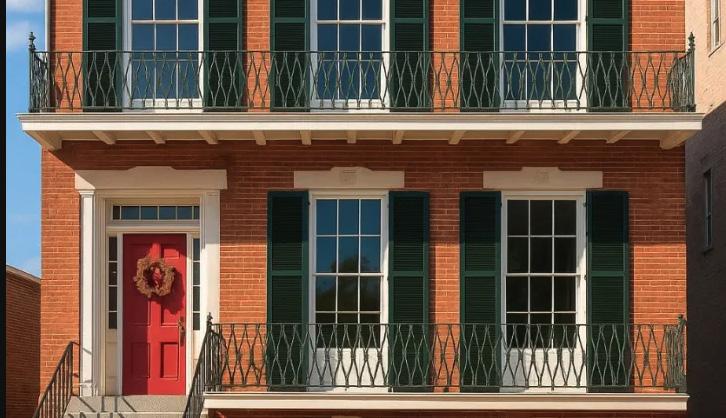
Rosemont Plantation, with its roots dating back to 1810, holds a captivating history that weaves through generations of the Davis family and reflects the broader tapestry of American life.
Established by the parents of Jefferson Davis, the plantation became the familial haven for the Davis family for an impressive five generations. Over the years, Rosemont underwent transitions in ownership, passing from the Davis family to Mr. Henry Johnson, a descendant of one of the early governors of Louisiana and then finding itself in the hands of Percival Beacroft of Texas and Mississippi.
Jefferson Davis, who would later become the only President of the Confederate States of America, considered Rosemont “where his memory began”. Although his recollections began at the age of two, his family relocated to Rosemont, overseeing the construction of the present home. The passing of Sam-
The mansion Rosalie, 100 Orleans St., occupies one of the most interesting historical tracts of land in Natchez.
In 1716, just south of the present mansion, the Frenchman Bienville erected Fort Rosalie on the bluffs overlooking the Mississippi River, making Natchez the oldest continuous settlement on the river — two years older than New Orleans.
When Natchez became a part of the new Mississippi Territory in 1798, the American flag was raised over the old fort. However, the fort was used a very short time after that and fell into ruins.
The land passed to Col. Henry Willis, an officer in the American Revolution, then to his daughter and son-in-law and, finally, to Peter Little, who built the mansion Rosalie in 1820.
Rosalie likely was designed by Little’s brother-in-law, James Griffin. Gardens enhance the beauty
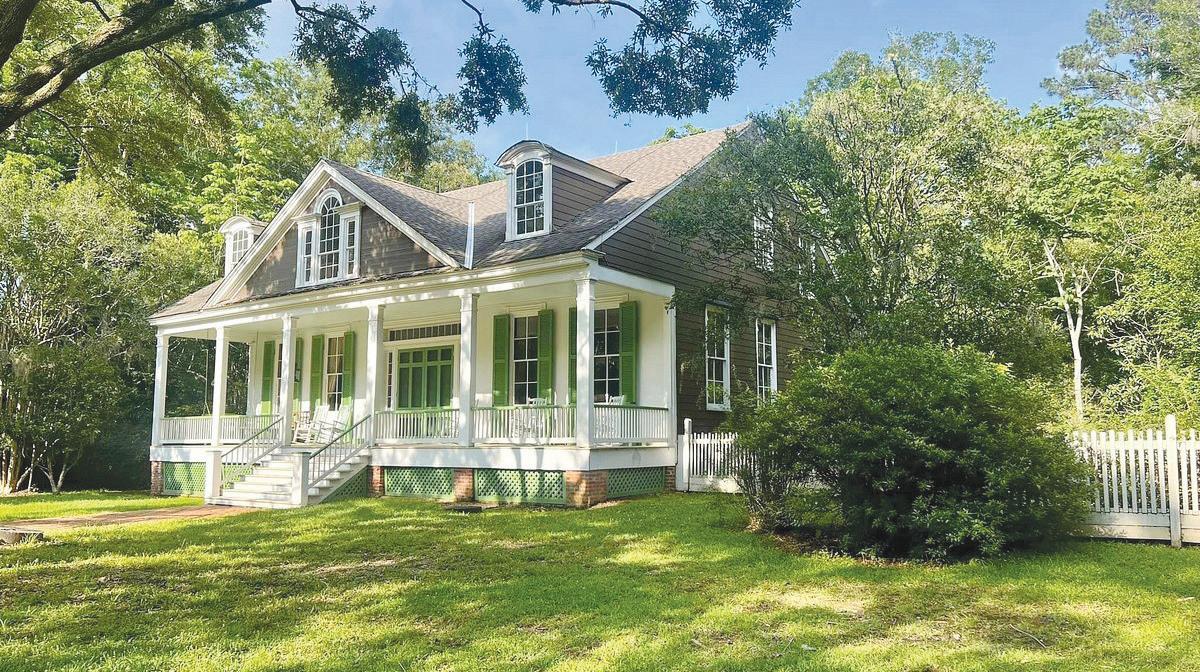
uel Davis, Jefferson’s father, marked a pivotal moment in the plantation’s history of Joseph Davis who assumed responsibility and became the new owner. His portrait graces the main house, a testament to his role in the family’s legacy.
Joseph Davis, an influential figure in his own right, emerged as a prominent lawyer and one of Mississippi’s wealthiest individuals during the 1840s. Noteworthy of his progressive views, Joseph believed in
educating African slaves within the system of slavery. To implement this vision, he established a court system where they would be tried by their peers. Only black overseers were used in Joseph Davis and Jefferson Davis plantations. Joseph Davis gave personal instructions in business to those talented in which it gave former slaves value after they were granted freedom. They managed the plantations, and craftsmen were brought to impart valuable
skills, setting the stage for business development.
The forward-thinking approach of Joseph Davis bore fruit when freedom arrived. Inhabitants of Hurricane Plantation, were well-prepared, with the first black legislator in Mississippi emerging from Joseph Davis’ visionary efforts.
The main house at Rosemont is characterized by Federal architecture, having seen minimal changes over two centuries and owned to only three families.
The influence of Joseph Davis on his brother Jefferson’s perspectives on slavery is evident in their shared ideas. Samuel Davis, a revolutionary War soldier, contributed to the fight for independence, adding another layer to Rosemont’s historical narrative.
Jefferson Davis maintained a lifelong connection to his family home, considering it sacred due to the presence of his mother and other family members’ graves.
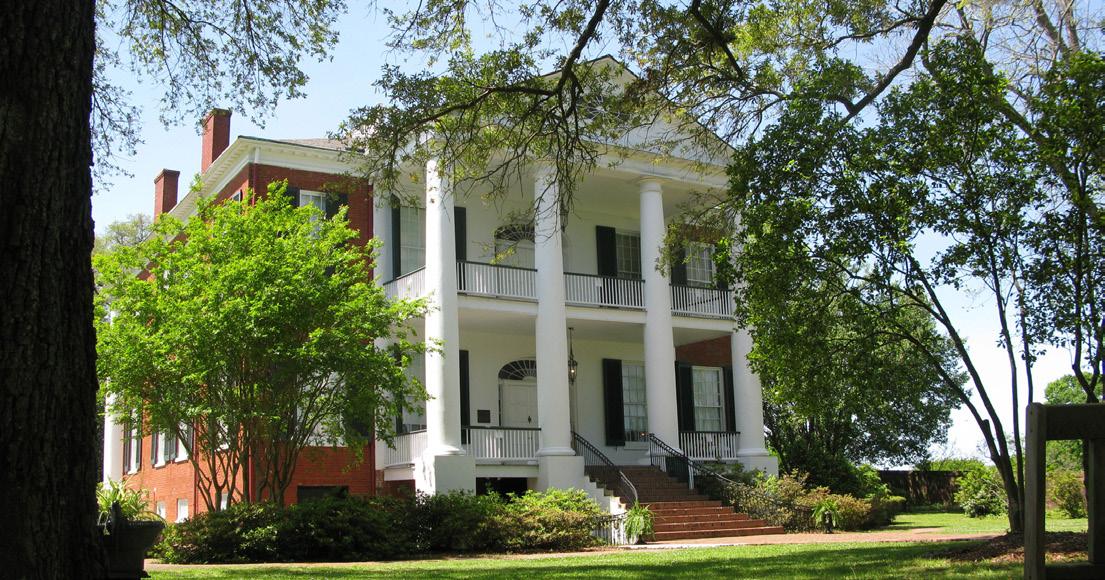
of the house, especially a marvel ous restored garden on the western side of the house overlooking the Mississippi River and the lowlands of Louisiana.
The beautiful Federal-style mansion was sold to Mr. and Mrs. Andrew L. Wilson in the 1850s, following the deaths of Little and his wife, Eliza.
During the Civil War, Mrs. Wilson was untiring in her services to the Confederacy and fell under suspicion during the federal occupation of Natchez. She was
arrested and banished to Atlanta. Rosalie, her home, became headquarters for the Union officers in Natchez and was the house where Ulysses S. Grant stopped on a trip through Natchez. In 1938, the Mississippi State Society of Daughters of the American Revolu tion bought Rosalie. Open daily year-round, the mansion houses many of it original furnishings.
The lower hall of Rosalie introduces the magnificence of the house.
It contains a grandfather clock,
several fine paintings and French porcelain vases. To the left are spacious double drawing rooms with original Belter parlor sets, antique pianos and white marble mantels with hand-carved roses and seashells. Over each mantel hangs a magnificent mirror.
Connected with these mirrors is a story of war and harrowing experiences.
Family tradition is that the mirrors went unscathed through the shelling of Natchez in 1862, only to get buried at the fort site when news spread that Union troops were approaching.
For several years the mirrors remained buried but when they were resurrected, they were unblemished. The library contains many old books and John James Audubon prints.
The dining room is opposite the second drawing room. A large gilt-framed oval mirror hangs above the white marble mantel,
Stanton Hall, one of the most magnificent houses of antebellum America, stands on a rise on High Street, bordered by Pearl Street on the west and Commerce Street on the east.
The magnificent Greek Revival-style house is surrounded by huge live oak trees more than a century old and is approached by entrances on each side leading to the front of the house.
Stanton Hall was built by Frederick Stanton, one of three brothers who came to America from Belfast, Ireland, in 1815. He settled in the Natchez area and married Hulda Helm.
Stanton became immensely wealthy as a cotton planter and cotton commission broker. In 1849, Stanton bought the square on which he was to build his dream house; construction was completed in 1857. Building the mansion to the designs of Natchez architect-builder Thomas Rose, Stanton spared no expense. Though Stanton did seek some of the furnishings for his mansion from outside Natchez, his confidence in the skills of local artisans was so high that all the work on the edifice was done by Natchez
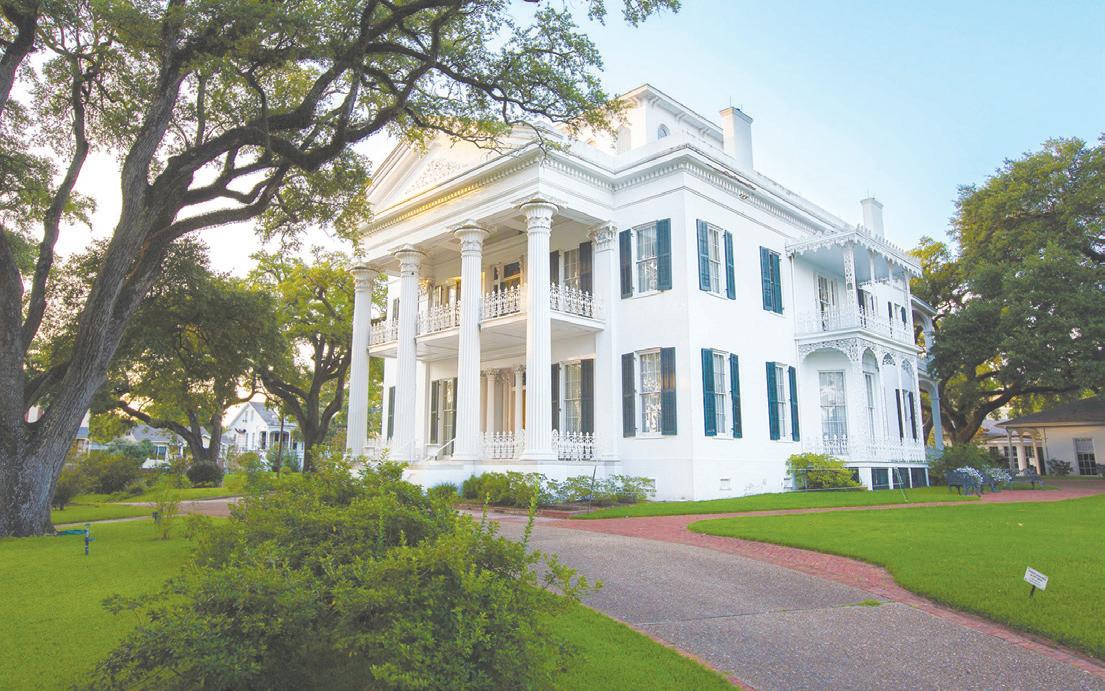
architects, builders, artists and finishers. The main hall is of impressive dimensions, with ceilings almost 17-feet high. An exquisitely carved overhead arch breaks the extreme length of the hall.
Circular arabesques embellish the ceilings, which are also bordered by narrow geometrical friezes. Furnishings in the hall include matching bronze chandeliers, which, like those in other rooms of the house, are attributed to the Cornelius firm of Philadelphia, Pennsylvania.
To the right of the hall are a large
Once a home to one of the most socially influential families in Natchez, the J.N. Stone House stands apart because of its origins as a private billiard hall.
The oldest part of J.N. Stone House was built in 1850 by David Stanton, brother of Frederic Stanton, who built Stanton Hall. The billiard hall was erected on the grounds of The Elms.
Prior to being expanded into a private residence, the structure served as a luxurious social gathering place for many Stanton family events.
David Stanton felt it necessary to expand the billiard hall and transform it into a house to accommodate his two sons, Samuel and Aaron.
The billiard hall, in its original form, was a single room, 22 feet long and 18 feet wide, built in the style of a Greek temple. Once the conversion from
rian furniture and a pair of pier tables with marble columns.
The beautiful carpet in both parlors is a reproduction of an 1850 Natchez design. It was made for Stanton Hall at the Ax Minster Carpet Mills in Greenville.
The small parlor contains an antique piano and an ornately carved window seat or meridienne made by John Belter of New York.
front parlor and smaller back parlor, sometimes called a music room. Together, these rooms are 72-feet long.
The length of the front parlor is broken by an elaborately carved and unsupported arch similar to the arch in the hall. Mantels in the parlors are of finest white Carrara marble, richly carved with fruits and flowers.
Silver-plated hardware is used on door knobs, hinges, key escutcheons, lock plates and call bells. Mirrors are original to the house, specially made in France. The parlor includes a matched set of highly carved Victo-
On the other side of the main hall is a library, containing an elaborately carved bookcase, two side chairs, a desk and desk chair belonging to Frederick Stanton and returned to Stanton Hall by his heirs.
Also on this side of the hall is a formal 35-foot dining room, centered with a Natchez-made dining table. Other furnishings include a set of early Empire chairs and a breakfront containing a large set of Old Paris china. Probably the most stunning items in the dining room are the many pieces of antique silver hollowware.
Some of the original Stanton Hall furnishings on display at the house include a highly carved American Gothic hat rack and two matching tall chairs.
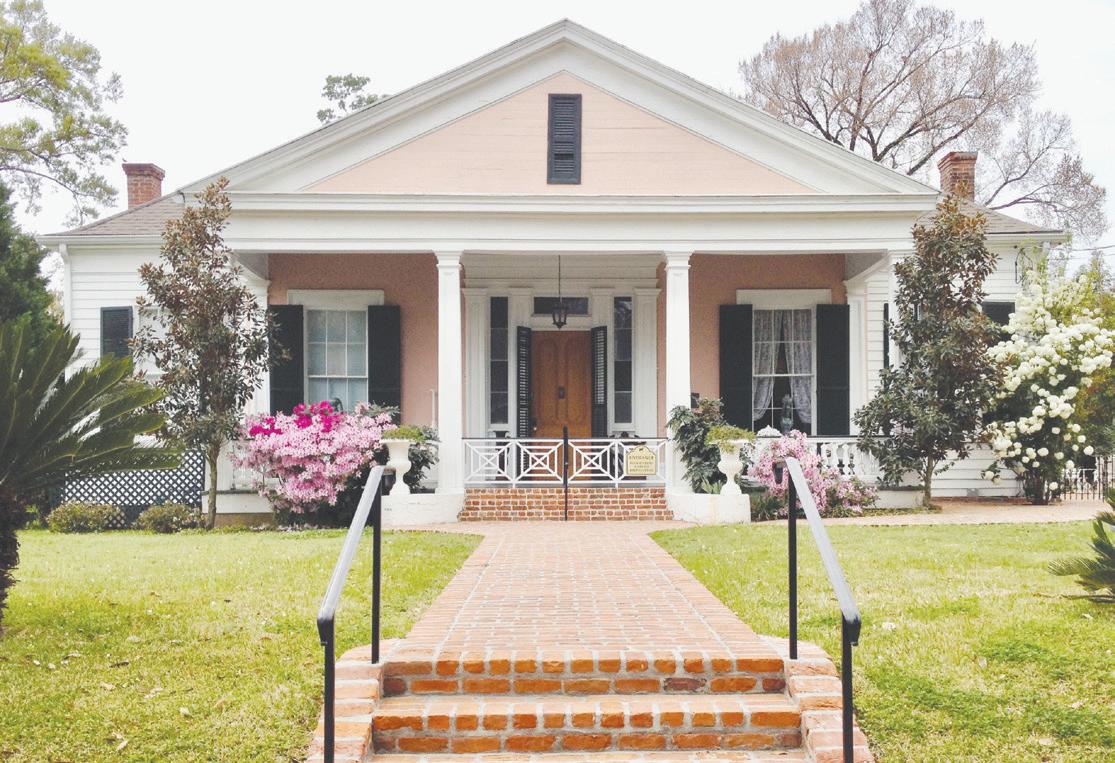
billiard hall to private residence began, the galleries in the front and down one side of the edifice were enclosed. Those areas became hallways which now include the original Greek revival entry. Also retained during the transformation was the plaster on cypress lathing on the interior and exterior walls of the home.
The plaster on the exterior walls is scored to resemble quarried stones.
Original plaster ceiling medallions are also located throughout the house. One of the ceiling medallions is accented by a period three-light gasolier with shades etched with a Greek key motif. Added during the renovation
were two fenestrated pocket doors that are ornamented with stained, etched and painted glasswork.
The doors, still present today, were used to divide the front addition from the back portion of the house, where the billiard hall had been.
In 1877, two Natchez natives, Joseph Newman Stone and his wife Theodora Britton, bought the house.
The house has been owned and occupied by descendants of the Stone family since its purchase in 1877. It is currently owned by Joseph B. Stone, great-grandson of Joseph Newman Stone. The J.N. Stone House is also home to a collection of antique maps and rare books. Included in the collection of family mementos is a personalized copy of “To Kill a Mockingbird” and a family photo of Harper Lee and Truman Capote.
It received the Foundation Award for Restoration in 2005.
Construction on this beautiful example of Greek Revival began in 1850. It was a modest home by Civil War standards. Sunnyside was a 150-acre working farm and dairy, complete with fruit and pecan orchards as well as extensive flower gardens. Often referred to as “The Forgotten Home,” you will find the entrance to this property on St. Catherine Street bordering the Forks of the Road, which was the second largest slave market in the U.S. at that time. Monmouth and Linden also bordered Sunnyside.
Colleen Wilkins began restoring the antebellum property in 2015, concentrating on both the inside of the historic home as well as the overgrown grounds.
The interior of Sunnyside has one of the largest art collections in Natchez as well as a library boasting around 5,000 books. It is currently used as a bed and breakfast. In addition, Sunnyside is an event venue. In compiling the history of the home, Wilkins turned to the Nation-
Nestled in the center of five lush acres with huge oak trees planted over 150 years ago, The Towers is one of Natchez’s grand mansions. Built in three stages, the house transformed from a frame cottage to the Italianate mansion it is today.
The original structure was created in three phases beginning in 1798 and resuming in 1826 and 1858. The house displays a unique and identifying trait, symmetrical towers on either end of the structure. In 1927, a fire in one of the towers reduced it to ash, and the house owners at the time had its mate removed that same year to maintain the house’s symmetrical look. An extensive interior and exterior renovation of the house included the recently completed massive restoration and reconstructed two towers, which are the genesis of the house’s name.
The cottage structure was built in 1798 and is still extant today, the central section was built in
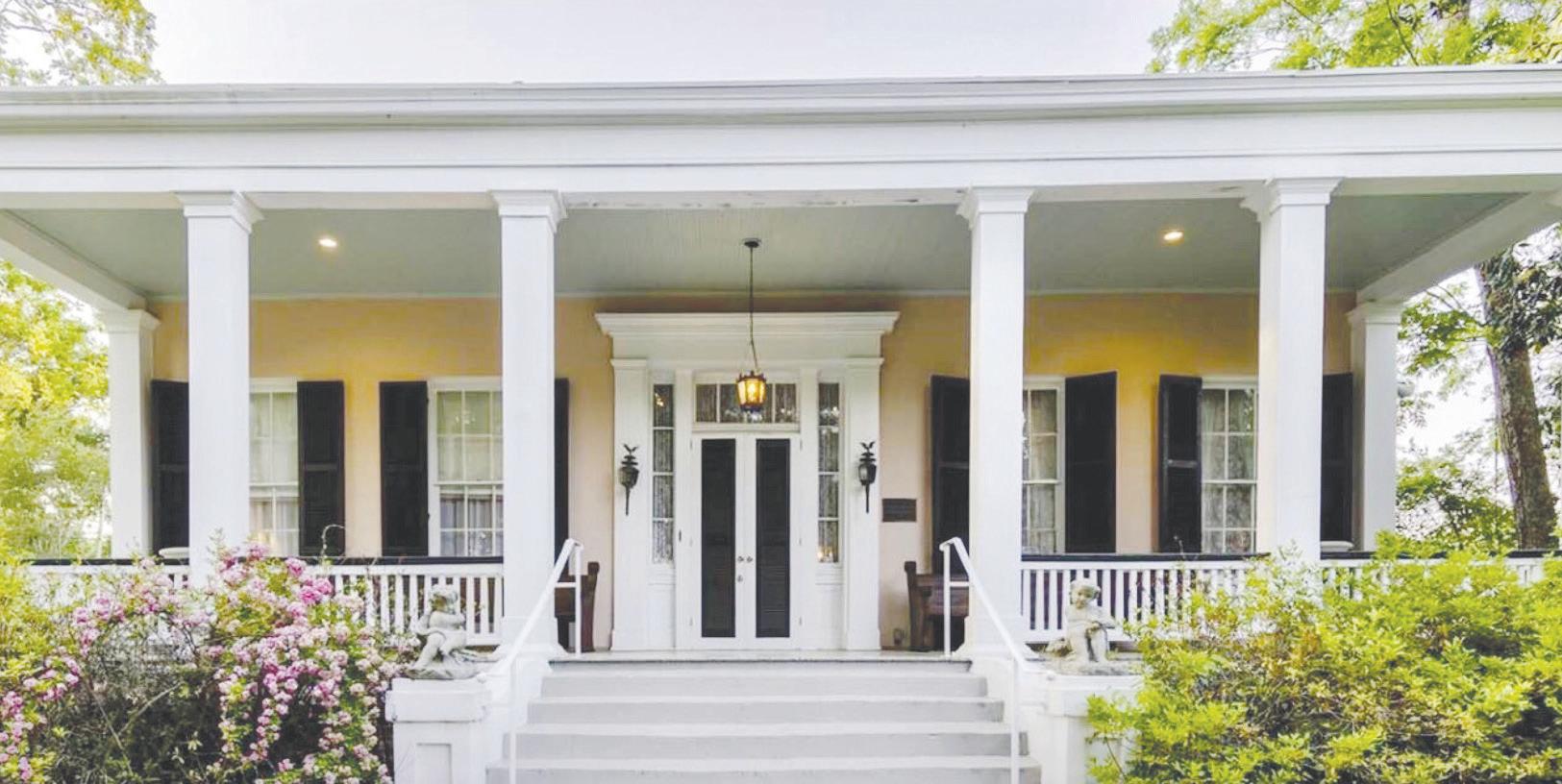
al Park Service and descendants of previous owners.
Reverend Watkins built the home in 1850. He was the first minister to occupy the Parsonage that was built by the owners of Rosalie. He and his wife, Elizabeth, along with his eight children lived there two years while Sunnyside was being constructed. He resided at Sunnyside for 25 subsequent years ministering mainly in Natchez. In 1864, the Union troops occupied Natchez. There was a troop from Wisconsin camped at the top
of the hill. One of the soldiers, Jones, fell in love with Watkins’ oldest daughter, Hattie. They welcomed this young man into their confidence. It so happened that the Confederacy contacted Rev. Watkins and asked him if he would contribute money, food and arms to the cause and Watkins quickly agreed as he had one son, his namesake William, who was fighting. This Union soldier, only known as Jones, went back to his camp and turned Rev. Watkins in. A provost officer and seven
guards came and arrested Watkins, along with two others. In a personal letter, he was quoted as remarking that he had never been so decieved in his life as he had been by this young man. It also stated that he was roughly treated. The commandant of the post in Natchez asked Watkins, “Do you know that by the laws of war the penalty for this offense with which you stand charged is death?” He answered, “I have not studied the laws of war, but only the gospel of peace.” His bail was set at $10,000. This was a huge sum of money which he would never be able to pay. He was later released and went on to minister in Natchez, Vicksburg and Jackson.
The second owners of Sunnyside were the Remberts. Diary pages have been shared with Wilkins, and with those they re-enact the “Wake of Annie Stewart,” a love story.
The third owners of Sunnyside have shared photos and memories of their family as well.
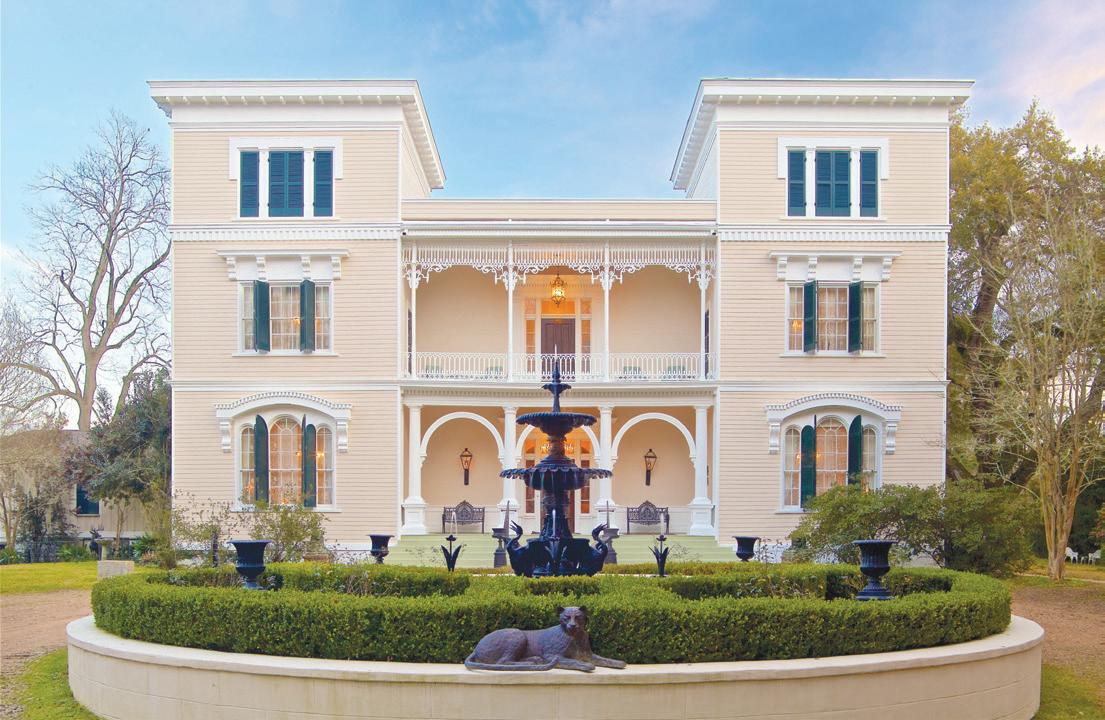
1826 and in 1858, the Italianate façade was added making it one of the purest examples of Italianate architecture in the city. The façade features a two-story recessed porch known as a loggia that is accented by three arches on each floor of the porch which is set between matching third-story rooms on each end of the house.
During the Union’s occupation of Natchez in the Civil War,
the Towers became part of Fort McPherson, a large earthwork fortification constructed in the northern section of Natchez. Union officers occupied the house and soldiers used the grounds as a campsite, pitching tents across the original eight acres of the grounds.
The home is furnished throughout with a large collection of Rococo Revival furnitur – 1840s to 1860s – from the great cabinet
and furniture makers of the era, John Henry Belter, John. J. Meeks, Alexander Roux and Prudent Mallards works can all be seen here. The interior renovation has been from floor to ceiling with highly decorative wall coverings, draperies, extensive plaster moldings, wainscoting and Aubusson carpets added throughout the house.
The current owners, Ginger and James Hyland have been renovating the home since 2006, and in addition have added to the magnificent home with an extensive collection of hundreds of antique beaded purses, crowns and tiaras, vintage costume jewelry, chatelaines and art glass. In fact, the Towers has been dubbed one of the nation’s most unique and must-see seasonal tours, with its “Jeweled Christmas at The Towers” with elaborate Christmas decorating using thousands of pieces of vintage rhinestone costume jewelry. The luxurious estate is exquisite at any time of year.
The Burn, built in 1834 is a beautifully detailed and proportioned suburban structure, and is the oldest documented Greek Revival residence in Natchez.
It was built as the residence of John P. Walworth, a wealthy planter, merchant, banker, and politician. Walworth, a Scotsman, commissioned T.J. Hoyt of New York as the architect and named his home The Burn, for the brook that ran through the property – the Scottish word for brook is “burn.”
Originally built on 100 acres, today she sits on approximately two acres of beautiful maintained grounds.
The Walworth family lived in The Burn for three generations until the 1930s when it was sold to the Laub family, who did much to restore the home and the gardens.
From the front, The Burn appears to be a one-and-a-half story
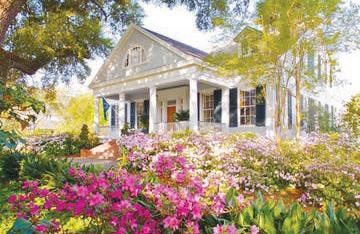
home, but the rear view reveals a full three stories. The main house has approximately 9,000 square feet. It has been said that the house was built in such a manner that it did not appear ostentatious.
One of the outstanding architectural features of The Burn is the
staircase, which rises in a short straight flight along the southerly hall wall before making a graceful half-circular turn through space to terminate in the upstairs hall. The newel is composed of a series of turned balusters, and the stair is adorned with ornamental brackets.
The home is furnished in period antiques by the current owners, who have a high sense of style and 19th century interior design. The only original furniture that remains in the house is the dining room table.
John Walworth came to Natchez by way of Ohio. He acquired three plantations, served as president of Planters Bank and served as an alderman and mayor of Natchez. By the year 1860, his real estate holdings totaled $300,000 and his personal property was valued at $26,000, making him one of the wealthiest men in Natchez.
In 1863, after the fall of Vicksburg, Natchez was occupied by Union troops. The family was given 24 hours to vacate their home. The Union army took The Burn and used it for a hospital. The family was not allowed back into their home until 1866.










Melrose, one of the outstanding classic Greek Revival homes in Natchez, stands just more than a mile from the heart of the city on Melrose-Montebello Parkway.
Today it is the centerpiece of the Natchez National Historical Park, established by Congress in 1988 and dedicated in 1990.
Beautiful Melrose stands in a spacious park-like setting.
The grounds are open, free of charge from 8:30 a.m. until 5 p.m. every day except Christmas, Thanksgiving and New Year’s. For more information contact the Natchez National Historical Park, 601-446-5790, or 601-442-7047.
Melrose stands today virtually as it did more than 138 years ago when it was constructed from a design by builder Jacob Byers of Hagerstown, Md.
The house was built in 18421848 by Mary Louisa and John T. McMurran. John T. McMurran came to Natchez in 1824 or 1825
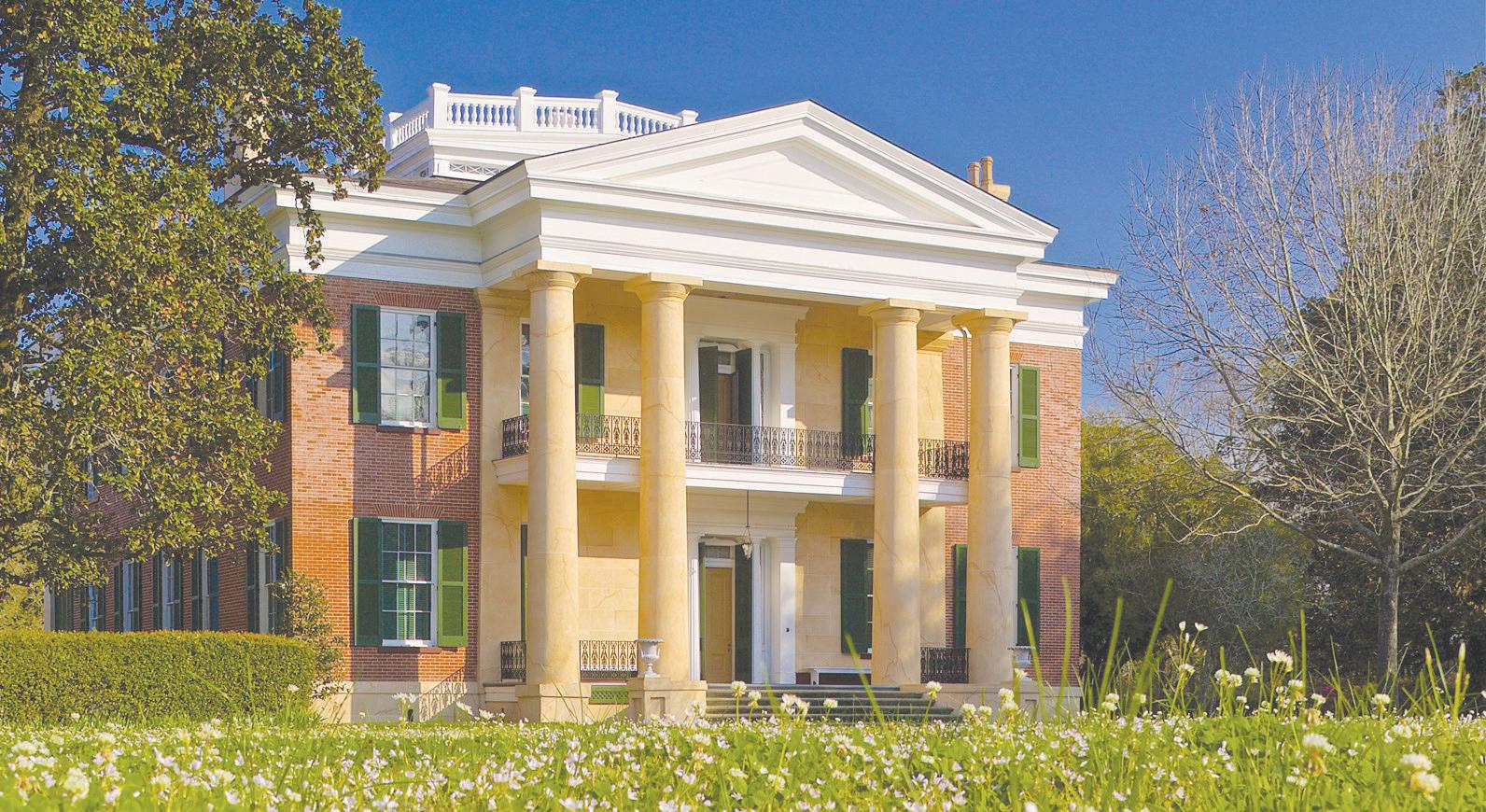
and soon became the law partner of John A Quitman, later governor of Mississippi, congressman and general. Mary Louisa McMurran was the daughter of well-known Judge Edward Turner and Eliza Turner.
The McMurrans sold Melrose in 1865 to Elizabeth Davis, wife of Natchez attorney and planter George Malin Davis and moved to nearby Woodland, home of Mrs. McMurran’s parents. George Malin Davis, a graduate of Yale Law School, moved his family to
Natchez from Pennsylvania. Davis practiced law in Natchez with Judge S.J. Boyd. In addition to Melrose, the Davis family owned other Natchez mansions, including Cherokee, Concord and Choctaw.
Davis and his wife, Elizabeth Shunk of Louisiana, had two children, Julia and Frances. Julia married Dr. Stephen Kelly of New York. Their son, George Malin Davis Kelly, inherited Melrose in 1883. He and his wife, Ethel Moore Kelly, moved from New York and
into Melrose in 1910.
After Mrs. Kelly’s death in 1975, the property was purchased in 1976 by Mr. and Mrs. John S. Callon.
The Callons retained the integrity of the house and the grounds while continuing to perfect details of both to their original state.
The Grecian purity of the architectural setting contrasts sharply with the ornate Rococo Revival and Empire furniture, bronze chandeliers, gold-framed mirrors and heavy draperies.
Melrose is most remarkable for the preservation and maintenance of the house, outbuildings and grounds. Melrose’s details begin with Doric columns and delicate railings at the front entrance and continue inside with 36 solid cypress original doors, which, having been hand painted to look like white oak, are called “faux bois” or “false wood,” 10 Italian marble fireplaces, French Zuber wallpaper made from wood blocks carved in 1843 and rare French gilt mirrors.














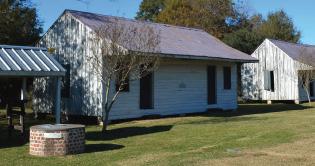
Just across the river at Frogmore Plantation, Louisiana, individuals and groups visiting Natchez and Vidalia can see first-hand “Cotton, Then and Now,” and see how John Gillespie and many other Natchez planters became millionaires from “King Cotton.”
Lynette Tanner, along with Lynn Mann and Kathy Forman, greet American and international tourists as part of the tour of the Tanners’ 200-year-old plantation complete with authentically furnished slave quarters, rare, Smithsonian quality, steam cotton gin, plantation church, overseer’s home, antique farm equipment, general store, and even a three-hole privy.
Frogmore Plantation, on U.S. Highway 84 just west of Ferriday, on the National Register of Historic Places, was the recipient of Louisiana’s state tourism award in 1999, was selected by Rand McNally in 2009 as a “MUST SEE” site, and according to the owners’ extensive research is the only such offering of realistic history of the progression of the South’s cotton industry, including slave ownership, cotton’s pre-Civil War boom, benefits and flaws of sharecropping, and later mechanization & computerization of the industry.
The Illinois born, but Louisiana raised owner (former teacher) stays in the learning mode with research well beyond tourism pamphlets and school text books.
Her love for history and its influence on today’s society comes naturally from her parents, the late Don and LaVonne Ater. Her parents and ancestors were all farming families, and Lynette grew up on a plantation.
After marriage, the Tanners,

along with constructing and oper ating their modern plantation, have restored 19 buildings and spent hours in research. Suddenly Lynette took on the role of tour guide, historian, and once again educator, while Buddy (previously named outstanding cotton ginner in the United States) became tour guide and advocate for United States agriculture.
Frogmore Plantation is an 1,800 acre working plantation, where cotton is planted, picked and ginned for the public each year.
The historical buildings are a collection of dependency buildings that date from 1790 to 1900, some of which were on Frogmore, and some originally on area plantations, now all carefully restored.
The restoration includes the Tanner’s plantation home, a complete village of slave quarters, an overseer’s cabin, a church, rare 1880’s steam gin, dozens of pieces of antique farm equipment and general store that serves as part museum, part gift shop with unique cotton and plantation specialties, and library of reference books for sale on slave culture, and all aspects of Delta life.
Two reconstructed buildings are also included in the tour, a smokehouse and pigeonnier. Modern tours of Frogmore include visiting the completely computerized cotton gin and viewing a video and display that illustrates modern seed, fertilizer, planting, and harvesting techniques.
Unusual products from the seed, world ag statistics, and cotton trivia are also part of the tour.
Frogmore is 20 minutes west of Natchez located at 11656 U. S. Highway 84, Frogmore, Louisiana.

